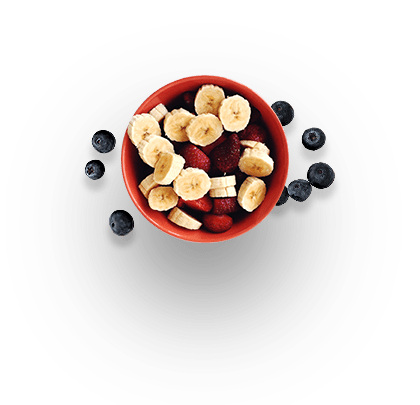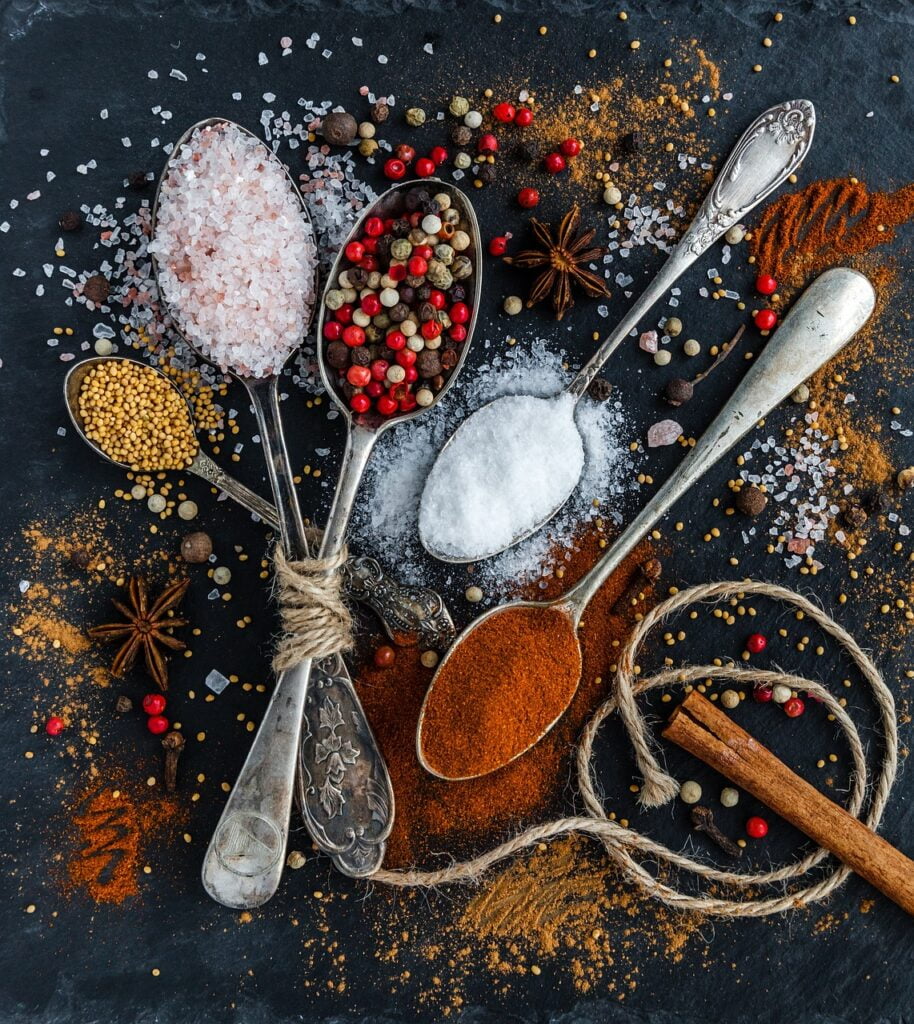
Spices, in general, enhance the taste of food. Spices are an essential part of Āyurvedic cooking. Āyurveda recognizes the medicinal qualities of spices. Āyurvedic cooking uses these spices intelligently to balance the doṣas, to enhance digestion (stimulates Pācaka pitta), to efficiently absorb nutrients, to improve circulation, to improve hormonal balance on an individual basis. All six tastes are included in the foods through an appropriate use of spices as well as other food ingredients that are suitable for the individual.
This helps in having a balanced meal that enhances the individual’s health.
Virya (Potency)
In terms of dietetics, rasa is of primary importance. In terms of herbs, vīrya is. Generally, Śīta vīrya increases kapha, while Uṣṇa vīrya increases pitta. Vāta works as a buffer. Among the six tastes, three have Śīta (cooling) vīrya and three have Uṣṇa (heating) vīrya.
Vīrya is divided into two types:
1. Sita (Cooling)
Actions: Increases vāta and kapha, decreases pitta, strengthens the dhātus, stops bowel movements and sweating, increases urination, weakens agni, creates a feeling of refreshment, tones dhātus, increases moistness, nourishes dhātus and creates blockages of channels.
Examples: Sandalwood, lotus, and aloe
2. Usna (Heating/Warming)
Actions: Decreases vāta and kapha, increases pitta, increases rakta dhātu, depletes the rest of the dhātus, dries stools and urine, increases sweat, causes agni dīpana and āma pācana, creates thirst, causes dizziness and opens the srotas.
Examples: Dry ginger, pippalī, and ginger
Cooking Spices List
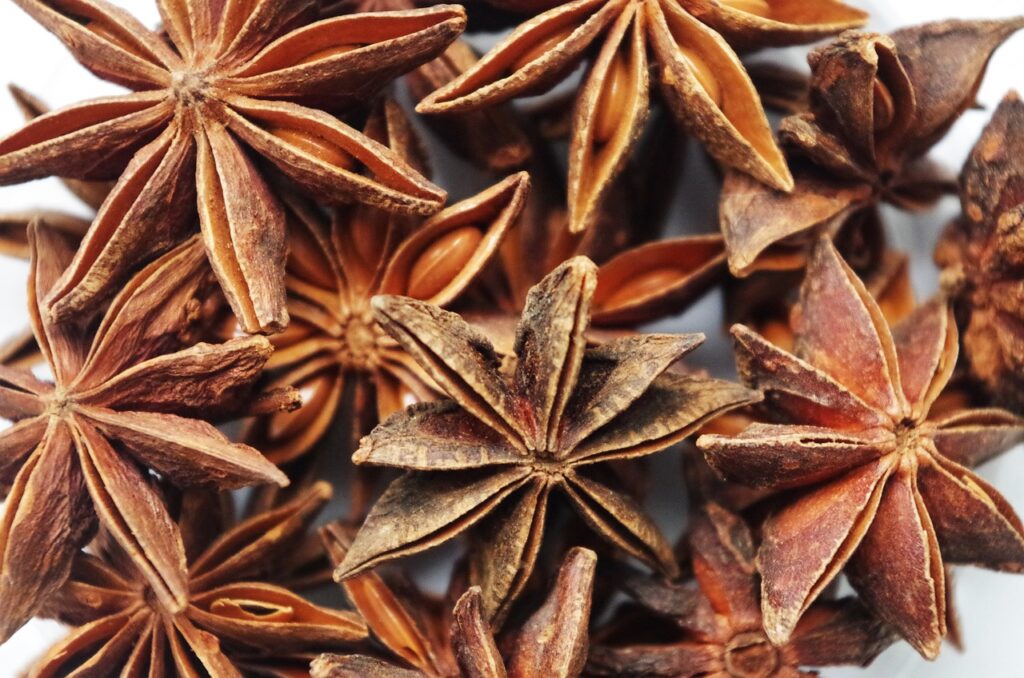
Anise (Sweet Fennel) (Shatapushpa)
Energetics: VK↓P↑
Taste/Rasa: Pungent
Potency/Virya: Hot
Vipaka: Pungent
Actions: Stimulant, carminative, lactogogue
Indications: Similar to fennel but is more pungent and warm, abdominal pain, gas, indigestion, menstrual cramping, vomiting, dry cough.
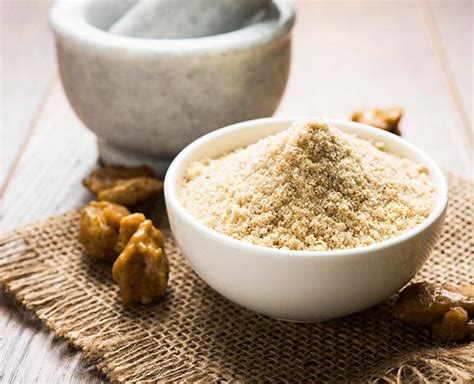
Asafoetida (Hing)
Energetics: VK↓P↑; Tamasic
Taste/Rasa: Pungent and raw hing has unpleasant odor
Potency/Virya: Hot
Vipaka: Pungent
Actions: Stimulant, carminative, antispasmodic, anthelmintic
Contraindications: Not for meditation or yoga; (tamasic), aggravates bile or acid conditions
Antidote: For beans
Indications: Some consider it the best Váyu spice, best for relieving abdominal distention, pain, cramping and gas, parasites, worms, candida, delayed or difficult menstruation, pain, anxiety, mental disorders—i.e., nervousness, vertigo, anxiety, hysteria, worry, depression, lethargy, cough, asthma, arthritis, headaches, nerve pain, paralysis, circulation; strengthens heart; palpitations, angina, exorcism.
Description: Is an Indian spice with a unique flavor. It is a dried resin, available in “rock” or ground form. Ground hing is generally cut with rice flour and is less potent. Hing is considered good for appetite and digestion. Some consider it the best Vata spice, best for relieving abdominal distention, pain, cramping and gas, parasites, worms, candida, delayed or difficult menstruation, pain, anxiety, mental disorders—i.e., nervousness, vertigo, anxiety, hysteria, worry, depression, lethargy, cough, asthma, arthritis, headaches, nerve pain, paralysis, circulation; strengthens heart; palpitations, angina, exorcism.
It is a warming spice and contributes to the pungent taste. Raw hing has an unpleasant odor. To release the true flavor of hing, you have to sauté it in oil or ghee. A pinch of ground hing goes a long way. Hing and mustard seeds sautéed in Ghee are poured over cooked lentils for aroma and flavor. The mixture of hing and mustard seeds, along with other spices, can be used to season vegetables or to make fruit chutneys.
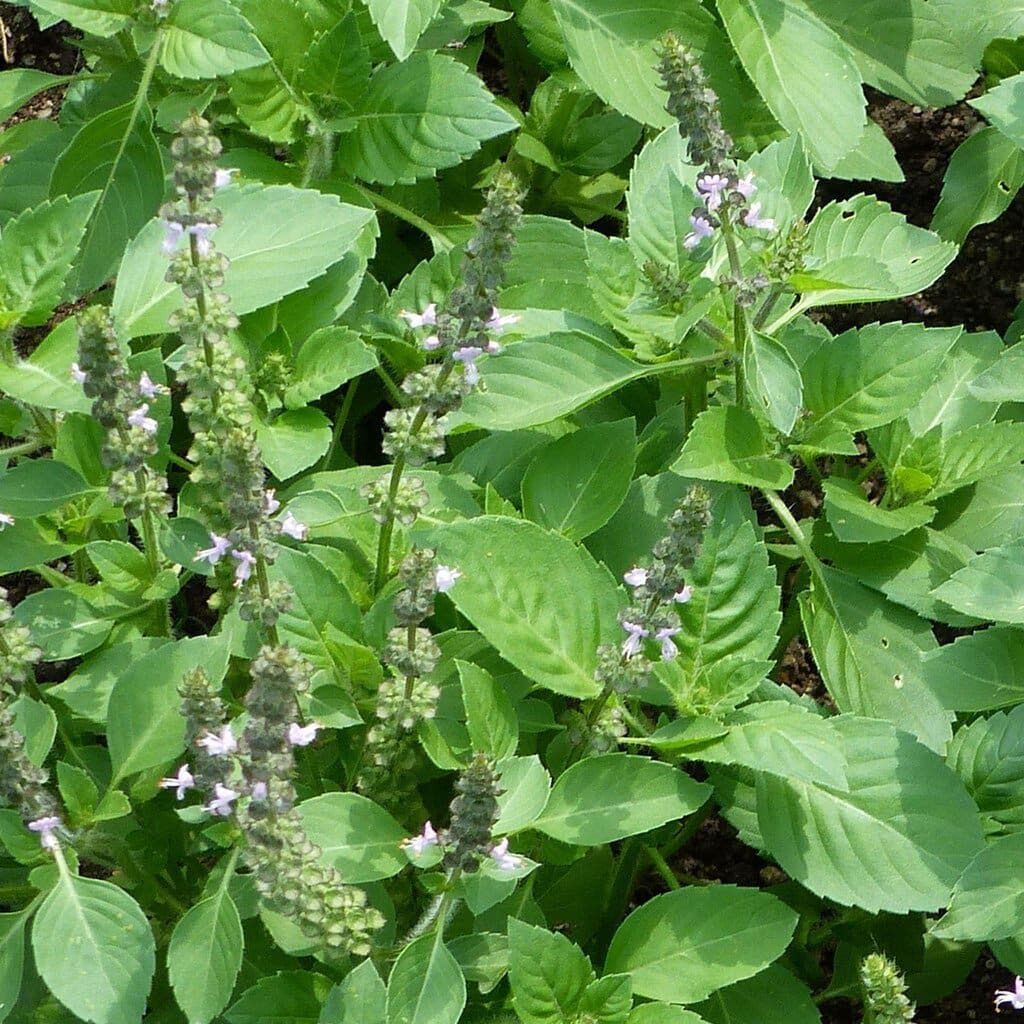
Basil/Holy Basil (tulsí)
Energetics: VK↓P↑ (P↑ in excess)
Taste/Rasa: Pungent
Potency/Virya: Hot
Vipaka: Pungent
Tissues: Plasma, blood, marrow and nerves, reproductive
Precautions: High Pitta
Actions: Antibacterial, antiseptic, analgesic, antispasmodic, diaphoretic, febrifuge, nervine, vermifuge
Indications: Coughs (including TB-caused), colds, excellent for fevers, lung/respiratory problems (práòavaha srotas)—liquefies phlegm, allergic bronchitis, asthma, eosinophilia. Abdominal distention, absorption/bioavailability, arthritis, colon (air excess), memory, nasal/sinus congestion, sinus headache (as snuff), blood and heart tonic; oxygenates the body, cleanses and clears the brain and nerves; strengthens nerve tissue, relieves depression and the effects of poisons; reduces pain, difficult urination, prevents the accumulation of fat in the body (especially for women after menopause), obstinate skin diseases, arthritis, rheumatism, first stages of many cancers, builds the immune system. Improves digestion and appetite and destroys áma, good for worms, empowers other
herbs. It is chewed for gum infection. Tulsí contains trace mineral copper (organic form), needed to absorb iron. Helps prevent hairloss and graying. Oil is used for earaches. Reduces swellings.
Description: Next to the Lotus, BASIL is perhaps the most sacred plant of India. Its quality is pure Sattva. Basil opens the heart and mind, bestowing the energy of love and devotion (bhakti). Sacred to Vishnu and Krishna, it strengthens faith, compassion and clarity. Tulsi stems are worn as rosaries and promote the energy of attachment. Basil gives the protection of the divine by clearing the aura and strengthening the immune system. It contains natural mercury, which, as the semen of Shiva, gives the seed-power of pure awareness.
A plant of basil should be kept in every house for its purifying influence. Basil absorbs positive ions, energizes negative ions, and liberates ozone from the sun’s rays.
Basil is an effective diaphoretic and febrifuge in most colds, flus and lung problems. It removes excess Kapha from the lungs and nasal passages, increasing Prana and promoting sensory acuity. It also removes high Vata from the colon, improves absorption and strengthens the nerve tissue, increasing memory. Basil may be taken as a beverage with honey for promoting clarity of mind.
The fresh leaf juice is used externally for fungal infections on the skin.
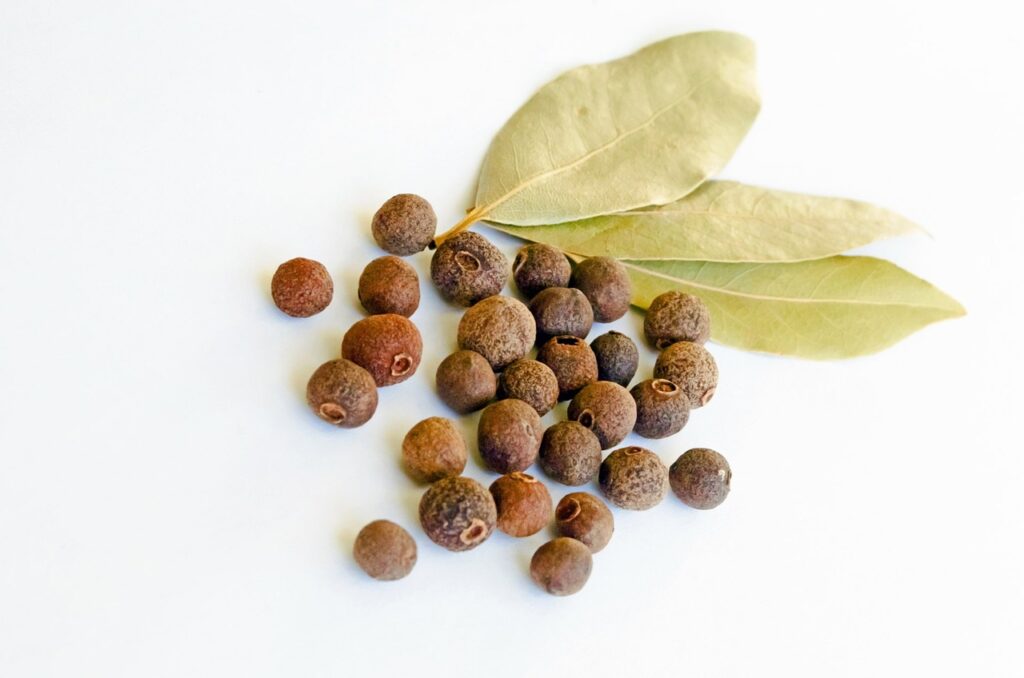
Bay Leaves
Energetics: VK↓ (P↑ midly)
Taste/Rasa: Pungent, bitter
Potency/Virya: Warming
Vipaka: Pungent
Antidote: Dairy, meat, damp sticky food
Actions: Stimulant, carminative, analgesic
Indications: Cleansing, headaches, clear srotas, cough and congestion, diarrhea, hemorrhoids. Useful as an insect repellent in the kitchen.
Description: Used in cooking are from the Laurus nobilis tree. The leaves are used whole. They are a little pungent and highly aromatic, should be used sparingly. They are warming, and pacify kapha and vāta and increase pitta. In Āyurveda, bay leaves are used in teas to help soothe respiratory problems and indigestion.
Bay leaves combine well with pepper, cinnamon, cardamom, and cloves, and this combination of whole spices is used to flavor Basmati rice. Bay leaves can be added to stews, soups, dals, and curries while they are simmering, and are generally removed before serving.
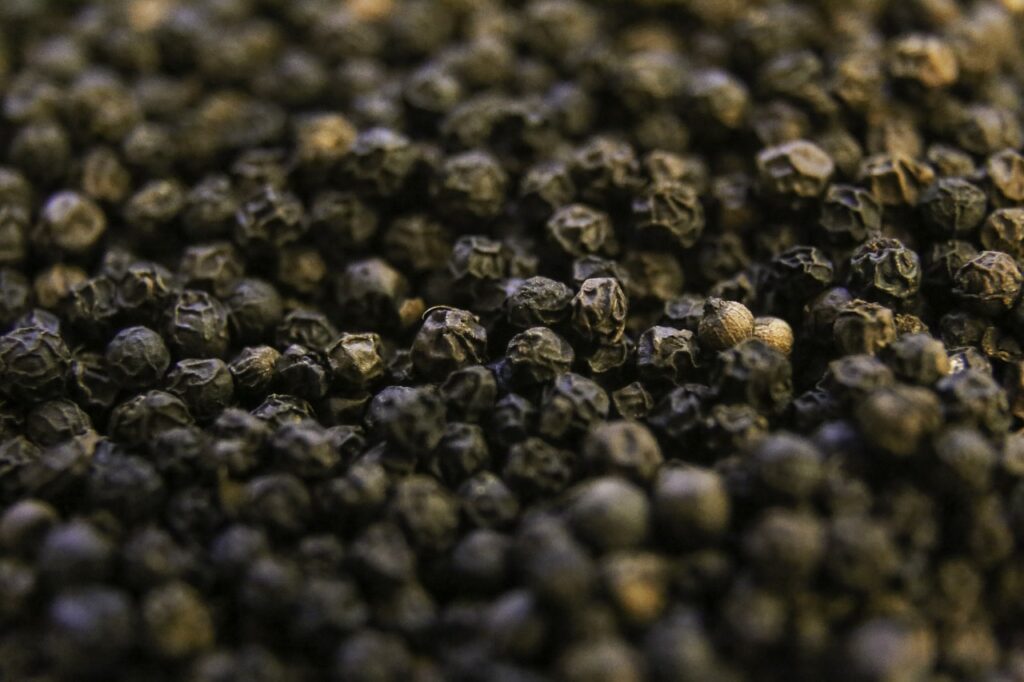
Black Pepper (Maricha)
Energetics: VK↓P↑; Rajasic
Taste/Rasa: Pungent
Potency/Virya: Hot
Vipaka: Pungent
Actions: Stimulant, carminative, decongestant, expectorant
Indications: Burns up áma very well, colds, flu, cough, gargle for sore throat, fevers, colon cleanse, digests fat and obesity; metabolism, mucus, expectorant, sinus congestion, cold extremities, raises agni, epileptic seizures, with honey, clears Kapha from the system in the morning. External—inflammations, urticaria, erysipelas.
Description: Is considered an important healing spice in Āyurveda. Along with long Pepper and ginger, it forms the herbal preparation called Trikaṭu, an essential ingredient in many Āyurvedic formulations. It has cleansing and antioxidant properties, and it is a bioavailability enhancer — it helps transport the benefits of other herbs to different parts of the body. It helps the free flow of oxygen to the brain, helps enhance digestion and circulation of nutrients, stimulates the appetite, and helps maintain respiratory system health and the health of the joints.
Black pepper is a warming spice and contributes to the pungent taste. It is excellent for pacifying kapha, helps pacify vāta, and increases pitta.
Aromatic black pepper is widely used as a seasoning in the Western world. In Āyurvedic cooking, black peppercorns, as well as ground or cracked black pepper, are common. Black peppercorns and other whole herbs such as cinnamon chips, bay leaves, cloves and cracked cardamom pods are sautéed in ghee and used to flavor Basmati rice. Ground black pepper is combined with coconut milk and other spices to make sauces for vegetables. Pepper combines well with almost every other spice or herb.
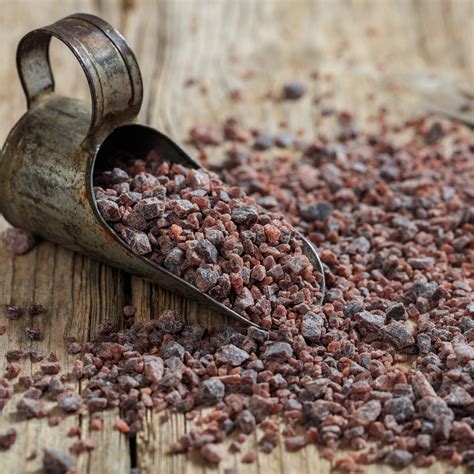
Black Salt (Kala Namak)
Energetics: V↓PK↑
Taste/Rasa: Sulfurous flavor and is an acquired taste
Potency/Virya: Warming
Indications: Has a sulfurous flavor and is an acquired taste for most people. It pacifies vāta and increases pitta and kapha. It contributes to the salty taste and has a heating quality. In Āyurveda, black salt is considered an aid to digestion. In combination with Ajwain and lemon juice, black salt helps balance digestion. A couple of pinches of black salt and 1/8 tsp. of dry-roasted ground cumin can be used to make digestive Lassi. Black salt, with lemon and cilantro, is used to make a dressing for spicy fruit salsa or chick-pea salads.
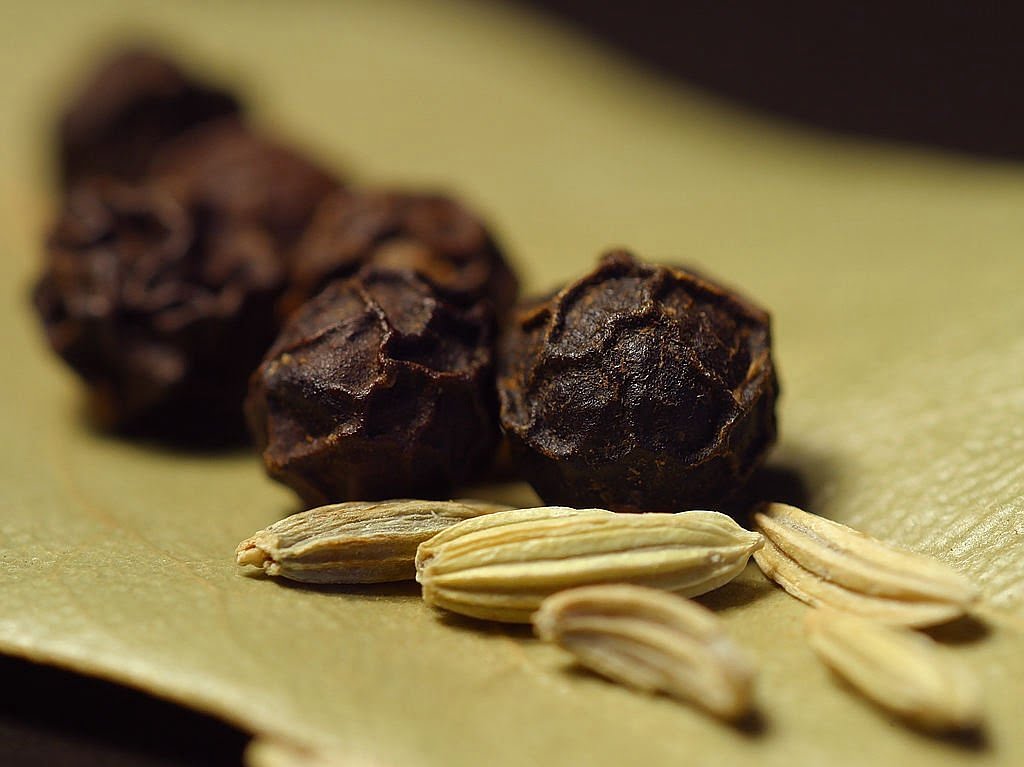
Caraway (Jíraka)
Energetics: K↓
Taste/Rasa: Sour, pungent
Potency/Virya: Hot
Vipaka: Sweet
Actions: Stimulant, carminative, lactogogue, diuretic (used like fennel and coriander)
Indications: Digests bread, like fennel and dill relatives; colitis, gas, digestion, abdominal pain, distention.
Antidote: Overeating, heavy foods
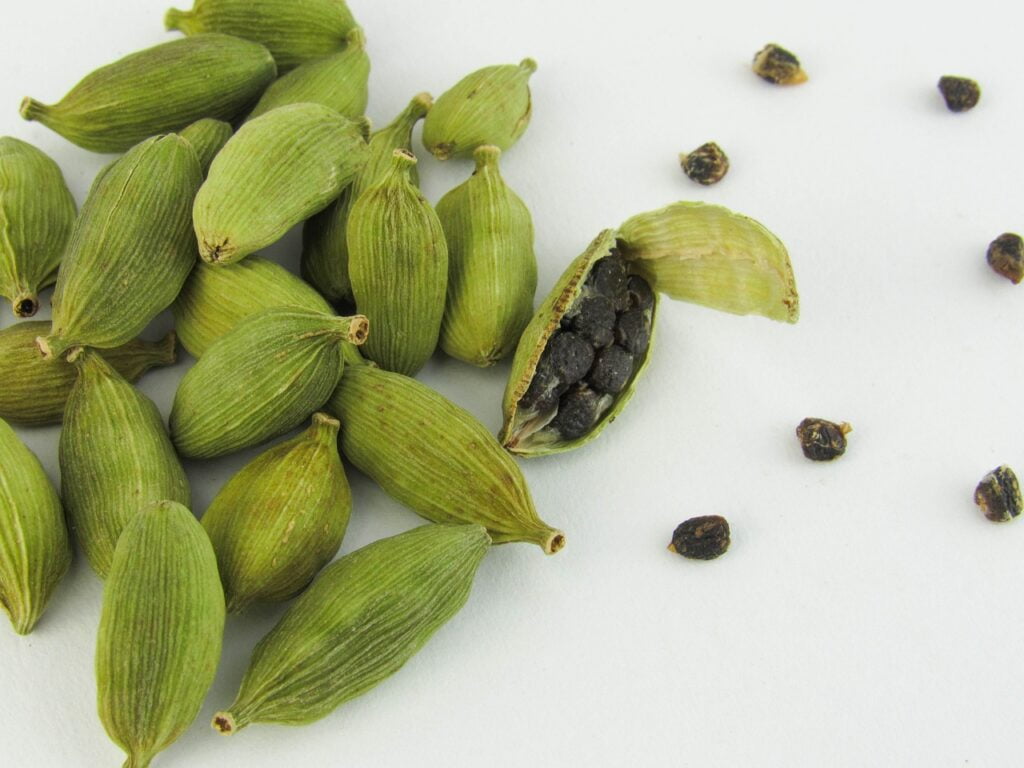
Cardamom (Elá)
Energetics: VK↓ (P↑ in excess); Sattvic, gives clarity and joy
Taste/Rasa: Sweet and Pungent with sharp flavor
Potency/Virya: Hot
Vipaka: Pungent
Actions: Carminative, diaphoretic, expectorant, digestive stimulant, stomachic
Indications: Main digestive herb. Absorption of nutrients, asthma, bronchitis, colds, cough, excellent for stomach complaints, hoarseness, indigestion, loss of taste, helps the spleen and pancreas, reduces Kapha in lungs and stomach, stimulates the mind, with milk it reduces mucus formation, detoxifies caffeine in coffee, nervous digestion, vomiting, headache, belching, acid indigestion, nausea, expels Vayu in colon and digests foods in colon, convalescing from diarrhea, biliousness, respiratory disorders, involuntary urination.
Is a warming spice that contributes to sweet and pungent tastes. It has a sharp flavor and is used extensively in desserts, especially in India and the Middle East.
According to Āyurveda, cardamom is tridoshic (good for balancing all three doshas), but people trying to keep pitta in balance should eat it in smaller amounts. Cardamom is considered an excellent digestive, especially beneficial in reducing bloating and intestinal gas. It is excellent for balancing kapha, particularly in the stomach and the lungs. It is also useful for pacifying vāta. The seeds are often chewed to refresh the breath.
Cardamom tastes best freshly powdered. It combines well with other sweet spices such as fennel and with pungent spices such as cloves. It can be used in baking, in sweet sauces and puddings, and in milkshakes that include fruits and nuts. Crushed cardamom can be used as a topping for fresh fruits and fruit salads. Try a large pinch of cardamom in lemon juice as a dressing on a carrot-raisin salad. Cracked cardamom pods add flavor to rice if added into the water at the start of cooking.
Precautions: Ulcers, high Pitta
Preparation: Infusion (don’t boil seeds), powder, milk decoction
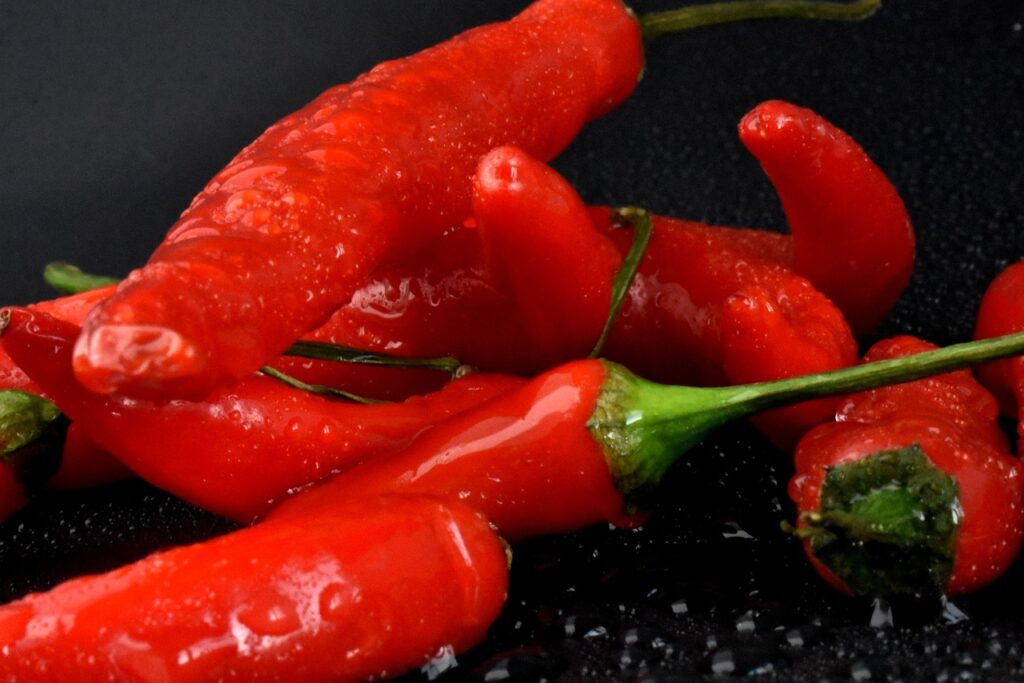
Cayenne (Marichaphalam)
Energetics: VK↓ (P↑ in excess); hottest; most yang; rajasic
Taste/Rasa: Pungent
Potency/Virya: Hot
Vipaka: Pungent
Actions: Stimulant, expectorant, diaphoretic, hemostatic, anthelmintic
Indications: A heart strengthener, circulation, gives energy after shock, heart attack or collapse; stops acute bleeding; absorption, chill, abdominal distention, worms, colds, flu, sinus congestion, cleanses colon, helps digest fats, burns áma.
Antidote: For raw food
Preparation: Very damaging to mucus membranes. Not an advised spice.
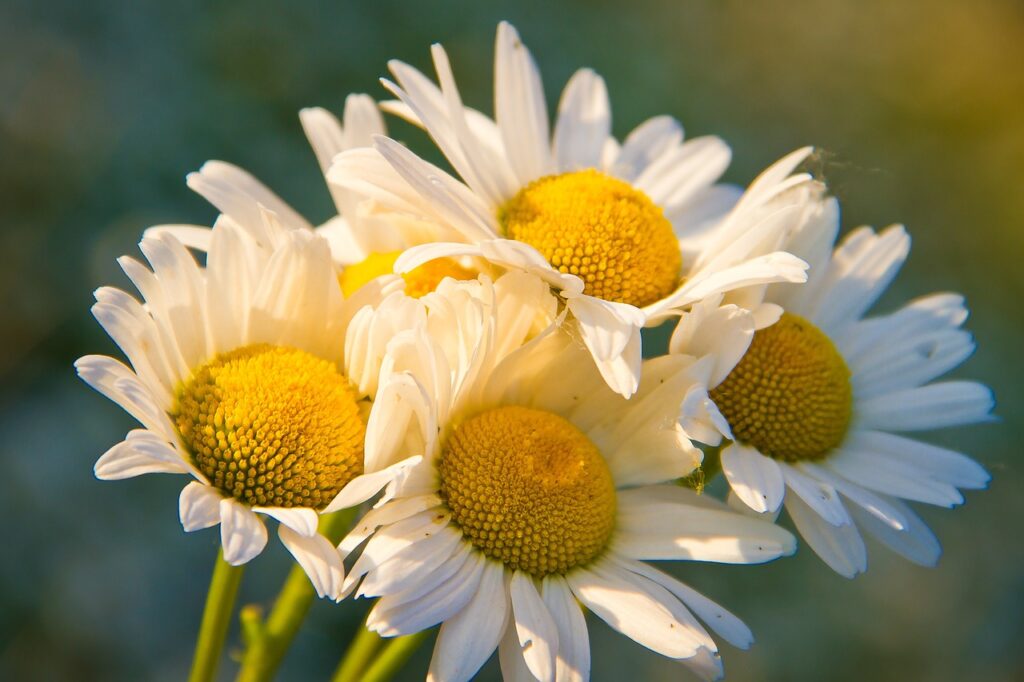
Chamomile (Babunike-phul – H)
Energetics: PK↓ (V↑ in excess); sattvic
Taste/Rasa: Pungent, bitter
Potency/Virya: Hot
Vipaka: Pungent
Precautions: Large dosages are emetic and may aggravate Vata
Tissues: Plasma, blood, muscles, marrow and nerve
Actions: Stimulant, antispasmodic, emmenagogue, emetic, diaphoretic, carminative analgesic, nervine, calmative
Indications: Pain, headaches; abdominal, children —nerves and digestion; colic, bile, blood, menstrual, ear, neuralgia, and injury pains; external use also; calms nervousness, anxiety, hysteria, insomnia, neurasthenia; poor digestion related to emaciation and nervousness.
Description: Is a popular beverage tea with many therapeutic values. In moderate amounts it is good for all constitutions, and it is a particularly good beverage for Pitta. It helps relieve bilious, digestive headaches, relieves congestion of the blood and promotes menstruation. It is a sattvic herb that is very balancing to the emotions. It sedates nerve pain and strengthens the eyes.
A little fresh ginger prepared with it makes chamomile a completely balanced beverage and counters any emetic effect it might have. Externally, it can be used as an eye wash or as a poultice for nerve pains. For most medical purposes its action is mild and serves as a harmonizing adjunct.
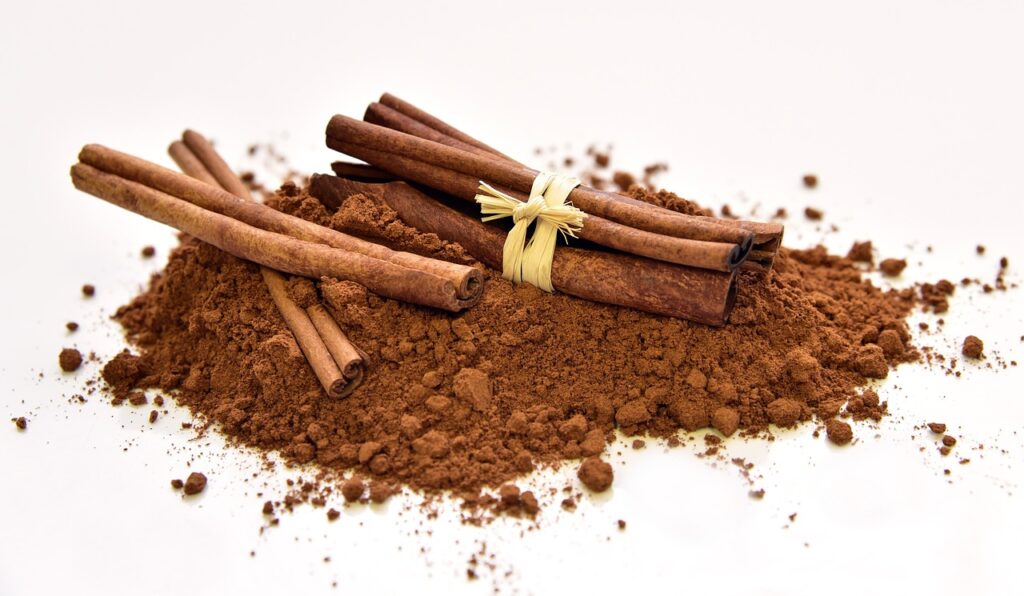
Cinnamon Bark (Thwak)
Energetics: VK↓ P↑; Sattvic
Taste/Rasa: Pungent, sweet, astringent
Potency/Virya: Warming
Vipaka: Sweet
Tissues: Plasma, blood, muscles, marrow and nerves
Actions: Stimulant, diaphoretic, carminative, alterative, expectorant, diuretic, analgesic
Precautions: High Pitta, bleeding disorders
Preparation: Infusion, decoction, powder (500 mg to 1 g)
Indications: Colds, sinus congestion, bronchitis, dyspepsia. Is often used in Āyurvedic herbal preparations to enhance the bioavailability of other herbs. It is a warming spice that contributes to the sweet, pungent, and bitter tastes. It is excellent for pacifying Kapha and good for balancing vāta also. Individuals trying to balance pitta can also consume cinnamon but in relatively smaller quantities.
In Āyurveda, cinnamon is used to balance digestion and to pacify stomach disorders. Combined with other warming herbs and spices like ginger and black pepper, it can be boiled into an herbal tea to soothe discomfort associated with colds. Its oil is used to pacify headaches and keep joints healthy.
Cinnamon is a very aromatic herb and is widely used to spice desserts and sweet dishes in the west. In Indian cooking, it is used to spice rich rice and vegetable dishes. The sticks are used to decorate rice dishes. Cinnamon combines well with many other spices, including ginger, cloves, black pepper, paprika, saffron, and nutmeg. Sauté cinnamon in ghee and add to desserts such as rice pudding or pie mixtures. A pinch can flavor nut-fruit milkshakes.
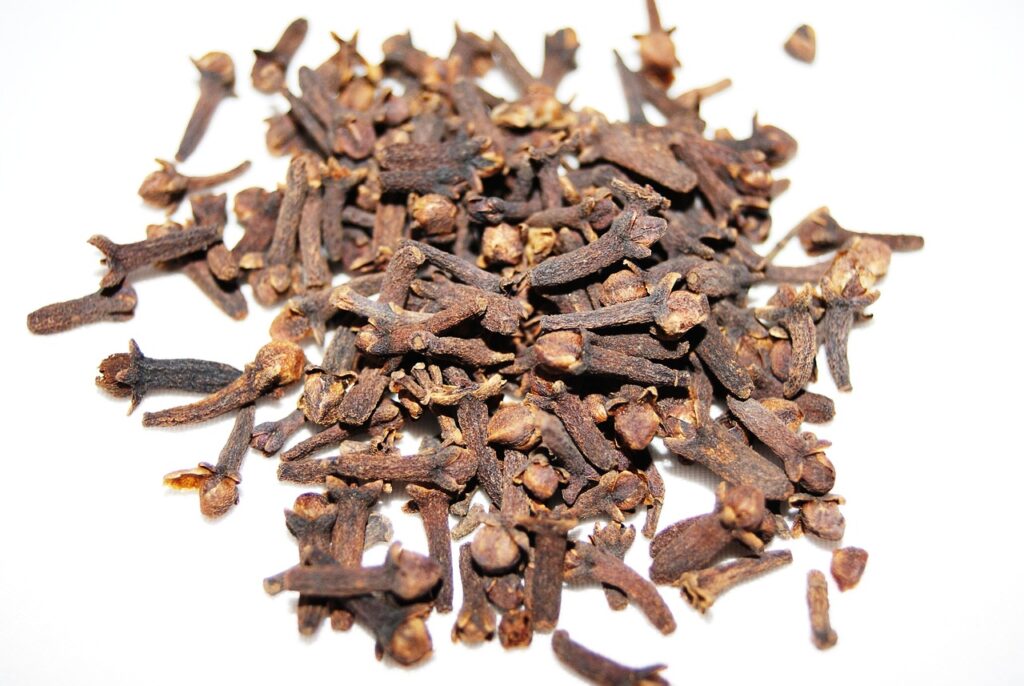
Clove (Lavangaha)
Energetics: VK↓P↑; Rajasic
Taste/Rasa: Pungent and bitter tastes
Potency/Virya: Warming
Vipaka: Pungent
Tissues: Plasma, muscle, marrow and nerve, reproductive
Actions: Stimulant, expectorant, decongestant, anthelmintic, analgesic, aphrodisiac
Indications: Colds, cough, asthma, indigestion, toothache, vomiting, hiccough, laryngitis, pharyngitis, low blood pressure, impotence
Indications: Is the dried unopened flower bud from an evergreen tree. The clove has been used in India and other parts of Asia for many centuries.
In Āyurveda, cloves are considered to enhance circulation, digestion, and metabolism and help counter stomach disorders such as gas, bloating, and nausea. The essential oil of clove is used as an ingredient in oral hygiene products to promote tooth health and freshen breath.
The clove has pungent and bitter tastes. Cloves help pacify vāta and kapha and increase pitta. Cloves are used both whole and ground in Āyurvedic cooking. Whole cloves sautéed in ghee with other spices such as cinnamon, bay leaves, and peppercorns enhance the flavor of rice and pilafs. Cloves are an essential ingredient in curry powders and combine well with other Āyurvedic spices such as turmeric, cinnamon, cumin, and coriander.
Gas, nausea, vomiting, toothache, hiccup, laryngitis, pharyngitis, headache, clears head, sinus and lungs, nerves, toothache, colds, cough, asthma, warms and disinfects the lymphatics, low blood pressure, impotence, indigestion, opens and clears srotas.
Precaution: Promotes sexual activity
Antidote: Sugars
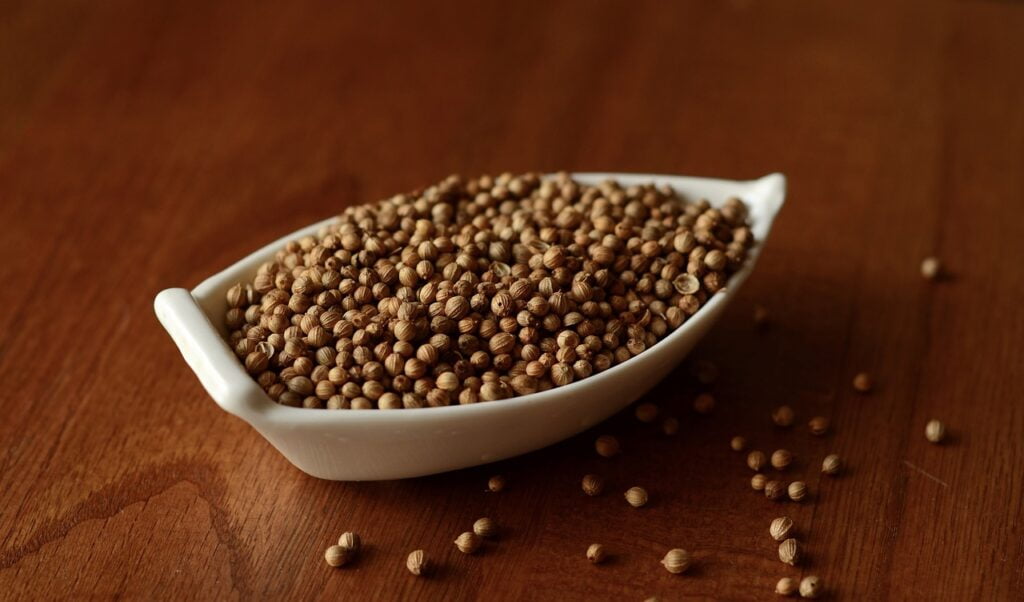
Coriander Seeds (Dhyanaka)
Energetics: VPK↓; Sattvic
Taste/Rasa: Bitter, pungent
Potency/Virya: Cooling
Tissues: Plasma, blood, muscle
Precautions: Not to be used in extreme Váyu nerve tissue deficiency
Indications: Are used commonly in Indian and Mexican cooking. They can be used whole but are normally used ground. Coriander is a tridoṣic spice highly appreciated in Āyurveda. It is a cooling spice and has sweet and astringent tastes. Āyurvedic texts suggest that it is good for digestion, whets the appetite, helps combat allergies, and also helps purify the blood. It can be combined with other Āyurvedic herbs such as ground turmeric, cumin, paprika, cayenne, and fennel. It has a sharp aroma and smells and tastes best freshly ground in a coffee or spice mill.
Ground coriander can be added to dals and vegetables as they are cooking. It can also be sautéed in ghee and added to cooked vegetables or lentils.
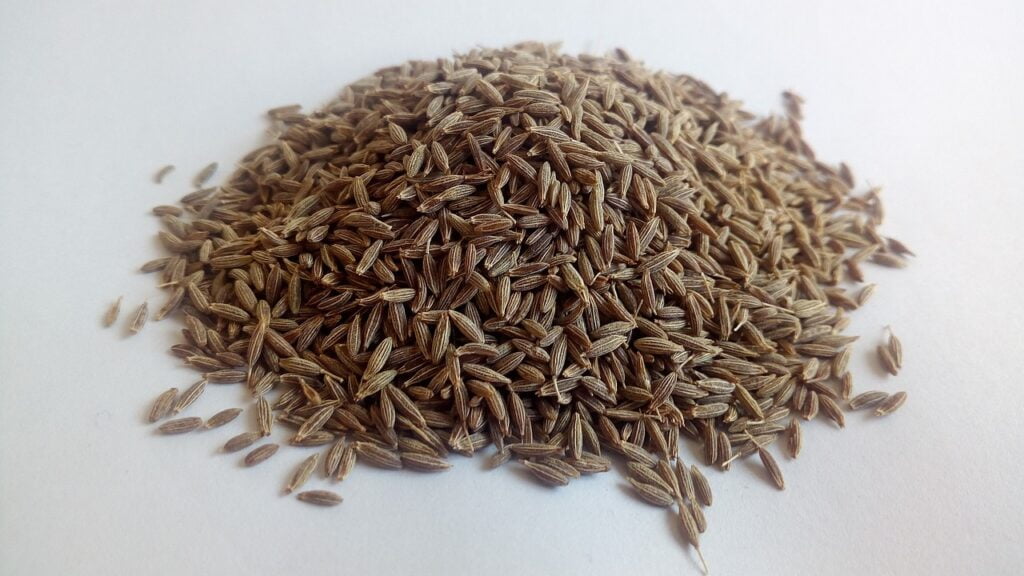
Cumin
Energetics: VPK↓; Sattvic
Taste/Rasa: Pungent
Potency/Virya: Warming
Vipaka: Pungent
Antidote: Overeating, heavy foods
Indications: Digests bread, like fennel and dill relatives; colitis, gas, digestion, abdominal pain, distention.
Description: Is popular in Indian, Mexican, and Middle Eastern cuisines. According to Āyurveda, it balances all three doṣas. It is supposed to aid digestion and help flush toxins out of the body.
Cumin can be used either as whole seeds or ground, raw or dry-roasted. Ground raw, it is a dull brown color, which is enriched by being sautéed in Ghee or oil. Powdered dry-roasted cumin is rich brown in color. Both sautéing and roasting make the aroma and flavor of cumin come alive. Cumin combines well with a wide range of other spices, including turmeric, ground fennel, ground coriander, ground dry ginger, and cinnamon.
Sprinkle ground, dry-roasted cumin on fresh yogurt lassi, add salt to taste and enjoy at lunch. Or blend yogurt, water (50-50) with ground, dry-roasted cumin, and salt to taste for a refreshing lunchtime drink. Called “Lassi” in India, this drink is excellent for digestion. This form of cumin can also be combined with some minced ginger, lemon juice, salt and black pepper to make a dressing for a warm salad of cooked white beans or lightly steamed shredded carrots. Whole cumin seeds, sautéed in ghee, make a flavorful addition to lentil and legume soups. Wholesome and nutritious, these soups can be meals in themselves.
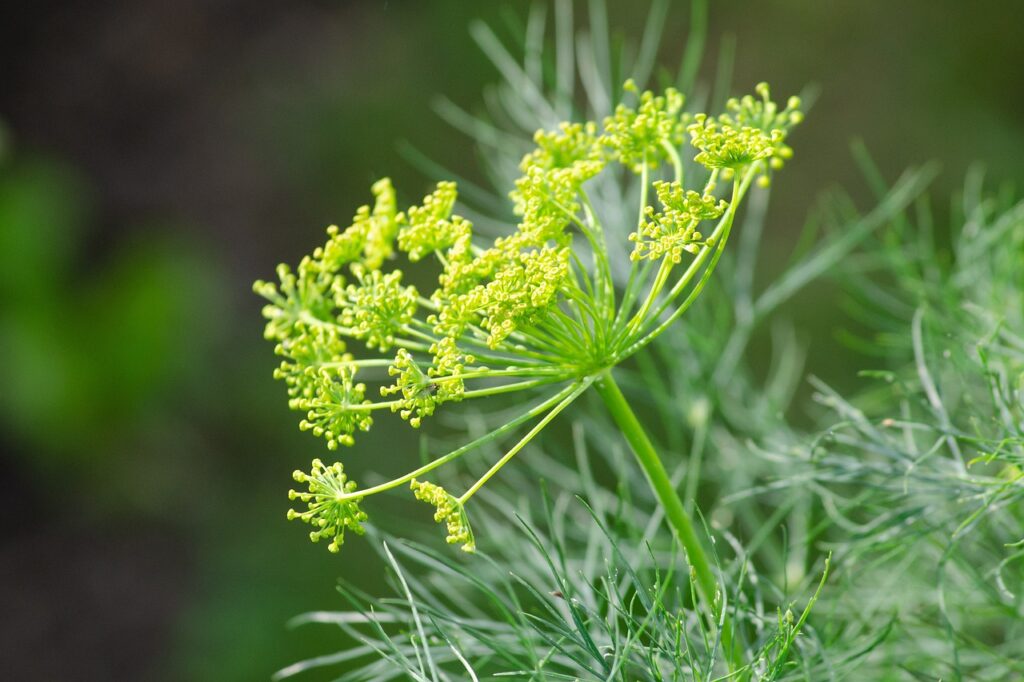
Dill (Misroya)
Energetics: VPK↓; Leaves cooler, seeds warmer
Taste/Rasa: Sweet, astringent
Potency/Virya: Hot
Vipaka: Sweet
Actions: Stimulant, antispasmodic, lactogogue
Indications: Colic, cramps, and diarrhea for children; similar to fennel.
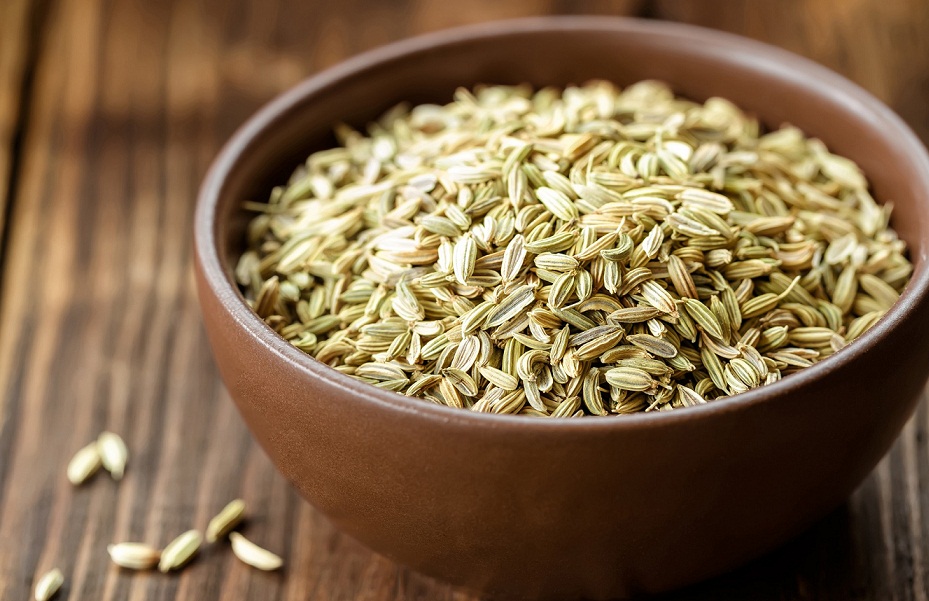
Fennel (Methica, Sonph)
Energetics: VPK↓; Perhaps the most sattvic spice
Taste/Rasa: Sweet taste with an undertone of the bitter taste
Potency/Virya: Cooling
Vipaka: Sweet
Actions: Stimulant, diuretic, carminative, stomachic, antispasmodic, lactogogue
Indications: Abdominal pain (gas or indigestion), menstrual cramps, hernia, diarrhea, colic, vomiting, morning sickness, nausea, anorexia, cough, dry cough, promotes semen, increases vision, raises agni, difficult or burning urination, digestion—children and elderly; promotes menstruation, nursing mothers—increases breast milk flow.
Description: Is a cooling spice, contributing mainly the sweet taste with an undertone of the bitter taste. Its taste is reminiscent of licorice. It has a nutty flavor and a strong aroma when sautéed in ghee. According to Āyurveda, fennel is extremely good for digestion. It acts as a general toner for the digestive system and is particularly good for enhancing agni, the digestive fire, without aggravating Pitta. In India, eating a few toasted fennel seeds after a meal is a common practice, both to aid digestion and to freshen the breath.
Fennel seeds can be used whole or ground. Whole fennel seeds, sautéed in Ghee, contribute aroma and flavor to dry vegetable dishes, and ground fennel works very well in sauces. Fennel combines well with other Āyurvedic spices such as cumin, coriander, dried ginger, and black pepper. Sauté turmeric, ground cumin, ground ginger, and ground fennel in Ghee, blend cashews in water to make a thin paste, and add to the spices to simmer-cook into a rich sauce for vegetables. Fennel seeds can be baked into cookies and muffins and a small quantity of ground fennel can be added to rice pudding for an exotic flavor.
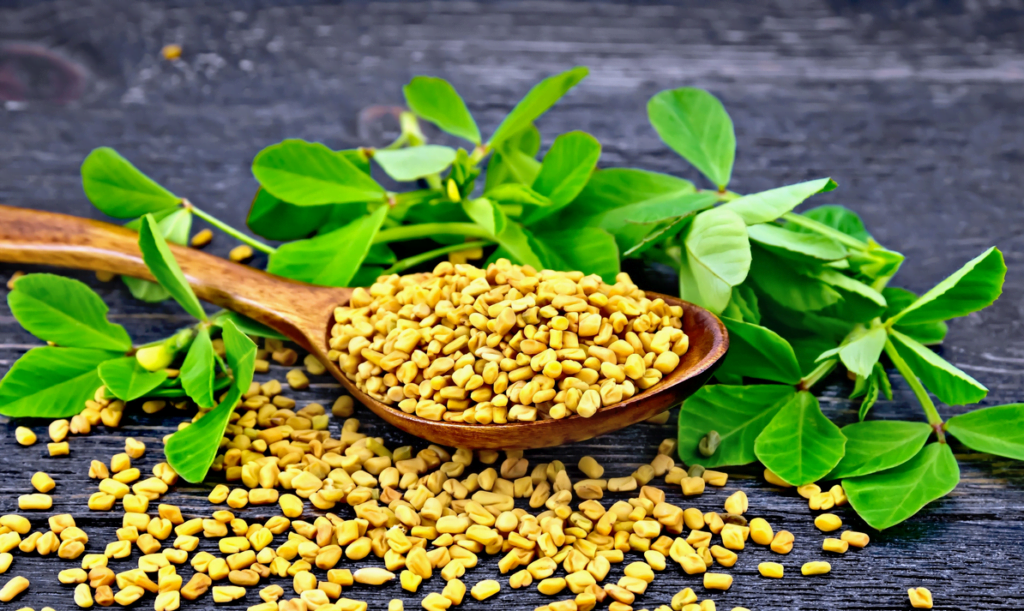
Fenugreek (Medhika, Methi)
Energetics: VK↓P↑
Taste/Rasa: Bitter, pungent and sweet tastes
Potency/Virya: Warming
Vipaka: Pungent
Tissues: Plasma, blood, marrow and nerve, reproductive
Precautions: Pregnancy (may cause abortion, promotes vaginal bleeding), high Pitta conditions
Indications: Longevity, nerves, allergies, arthritis, skin, rejuvenation, diabetes, allergies, bronchitis, flu, chronic cough, dysentery, dyspepsia, convalescence, edema, toothache, sciatica, neurasthenia, counters cold (i.e., extremities, abdominal pain, indigestion, respiratory and reproductive systems, hair growth, promotes breast milk flow, liver hypo-function, seminal debility, debility, outdoor winter work)
Description: Is excellent for pacifying kapha, and in smaller quantities for vāta, but it increases pitta. It is a warming spice that has bitter, pungent, and sweet tastes. In Āyurveda it is used to enhance digestion and prevent stomach disorders. It is also good for the skin and hair.
Fenugreek seeds are used both whole and ground. As with many other Āyurvedic spices, it is best to sauté whole or ground fenugreek in ghee before adding it to dishes. Fenugreek combines well with other spices such as cumin, coriander, turmeric, fennel, and dried ginger.
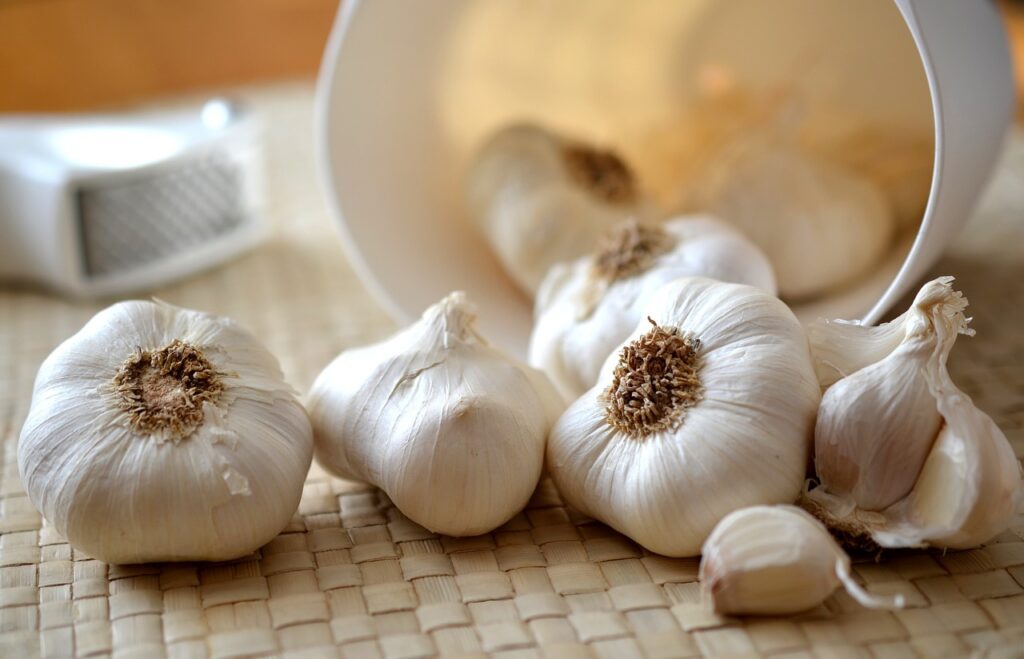
Garlic
Energetics: VK↓P↑
Taste/Rasa: All but sour, mainly pungent
Potency/Virya: Warming
Vipaka: Pungent
Precautions: Hyperacidity, toxic heat in the blood, high Pitta
Tissues: Works on all tissue-elements
Actions: Stimulant, carminative, expectorant, alterative, antispasmodic, aphrodisiac, disinfectant, anthelmintic, rejuvenative
Indications: Colds, cough, asthma, heart disease, hypertension, cholesterol, arteriosclerosis, palpitation, skin diseases, parasitic infections, rheumatism, hemorrhoids, edema, impotence, hysteria
Description: Is another important spice widely used in foods and for health promotion. Being pungent increases pitta and lowers vāta and kapha. Garlic adds taste to foods, so it is used in many gravies and soups. The use of garlic in lowering cholesterol is well known. It is used to reduce swelling and pain. Garlic-treated oil is useful in earache. It helps in congestion, cough, and asthma. In the postpartum stage, garlic helps to lower vāta aggravation and many aches and pains.
Is a powerful rejuvenative herb. It is a rasayana for Vata, and also, to a lesser degree, for Kapha, for the bone and nerve tissue. It also is a powerful detoxifier and is good for chronic or periodic {Vata) fevers. It cleanses Ama and Kapha from the blood and lymphatics. Yet its heating attribute can aggravate the blood and cause or aggravate bleeding.
Its quality is tamasic. Garlic can increase dullness of mind while, on the other hand, may increase “groundedness.” It increases semen but also has an irritant effect upon the reproductive organs. So while good as a medicine, garlic may not be a good common-usage herb for those practicing yoga.
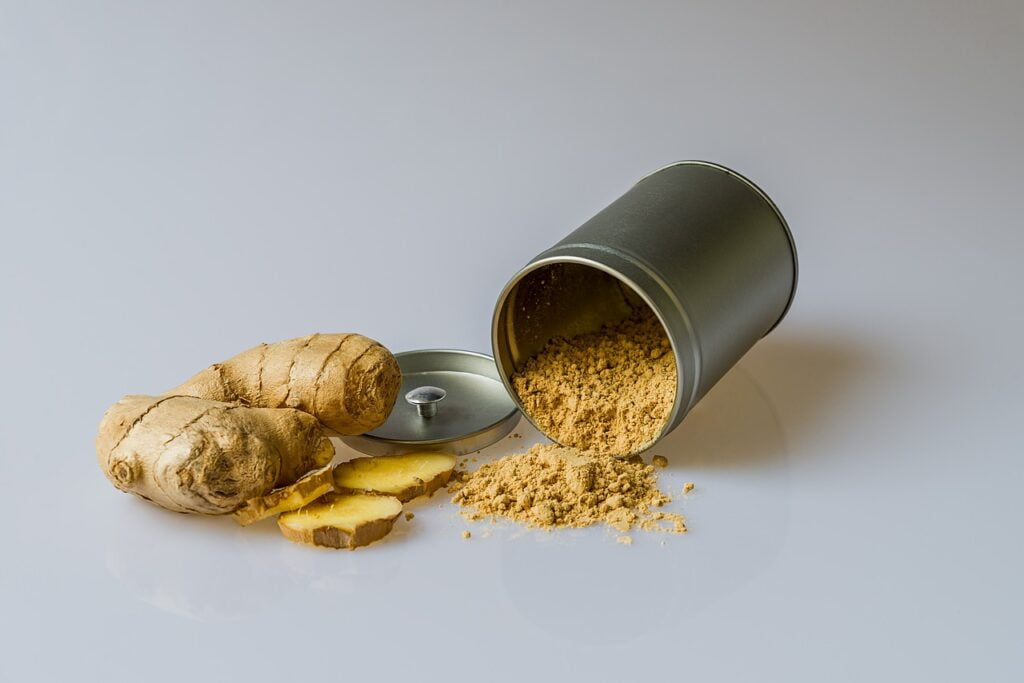
Ginger (Fresh/Dry) – Adrak/Sunthi
Energetics: VK↓P↑ (Fresh); VPK↓ (Dry); Most sattvic (spiritually pure) spice
Taste/Rasa: Pungent, sweet
Potency/Virya: Hot
Vipaka: Sweet
Precautions: Aggravates Pitta (i.e., inflamed skin diseases, fever, bleeding, ulcers, etc.)
Tissues: Works on all tissue-elements
Preparation: Fresh juice, infusion, decoction, powder, pill, paste
Actions: Analgesic, antiemetic, aromatic, aphrodisiac, carminative, diaphoretic, digestive, expectorant, nervine, sialagogue, stimulant.
Indications: Colds, flus, headache, lung congestion, joint and muscle pain, improves pulse and appetite, enhances joy and creativity
Description: Ginger is truly a wonder drug, having so many healing properties. It was called the universal medicine. Taken with rock salt it reduces Váyu; with rock candy it reduces Pitta; with honey it reduces Kapha.
Fresh: Mixed juice with water and cane sugar, boiled to a syrup—add saffron and powders of cardamom, nutmeg, and clove and preserve well. This ginger-jam, called Allaepauk, is useful indigestion, flatulence, colic, vomiting, spasms, stomach and bowel pains with fever, colds, cough, asthma, and increasing Pachaka Agni (responsible for digestion).
For indigestion, mix equal parts juice with lemon juice and rock salt (found in Indian groceries), and take just before meals. Taking the juice with rock salt, before meals, cleanses the throat and tongue, and increases the appetite. For bile and delirium due to biliousness, take ginger juice with cow’s milk (2:7 ratio), boil to half volume and add rock-candy powder, and take before bed. Or mix juice with mango juice, cane sugar, and cow ghee; mix and melt to half the quantity and take mornings and evenings.
For sore throats, hoarseness, and laryngitis, sometimes chewing a piece of fresh ginger produces saliva and soothes these conditions. Juice rubbed on navel relieves diarrhea. Ginger and onion juice relieve nausea, vomiting, and retching. Juice with rock candy (twice daily) remedies diabetes (mellitus and insipidus), For nervous headache, mix ginger juice with milk, let dry, and use as snuff.
Dry: With black and long peppers (trikatu) it is a carminative. Added to purgatives, it prevents nausea and the gripe. For indigestion and low appetite, mix with ghee or hot water. With painful bowels or stomach make an infusion of dry ginger, and mix with 1-2 tbs. castor oil. Alternatively, mix some asafoetida with ginger powder. For chronic rheumatic pain (Váyu or Kapha), colds, excess mucus, take ginger powder tea before bed, and cover up with blankets to promote sweating. In cases of headaches, make a paste of ginger and aloe gel or water, and apply to the head and take a nap or before evening sleep. The same paste maybe applied to the face for tooth or face aches. For headaches caused by nerves, mix a paste of ginger, cinnamon, castor root, and cloves (equal parts); and apply to the head.
For fainting, apply a thin paste of ginger and water to the eyelids, or place a mix of sunthi, black pepper and pippalí under the nostrils in small pinches. This will also help stupor, delirium and senselessness caused by brain fever.
Other uses: Arthritis, belching, heart disease, laryngitis (use as a tea and an external paste on throat), vomiting, constipation, strengthens memory, removes obstructions in the vessels, incontinence, flatulence, colic, spasms, fever, eye diseases, and asthma. Juice is better for colds, cough, vomiting, deranged Váyu, and as a diaphoretic. Dry ginger is better for increasing agni and reducing Kapha.
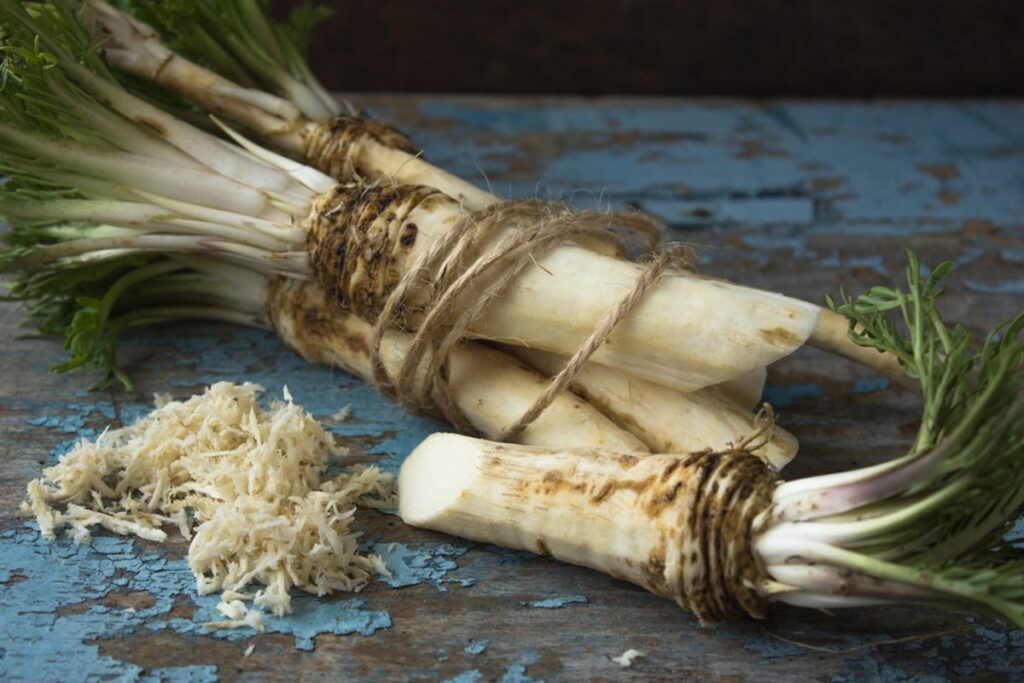
Horseradish (Sobhanjana, Sirgu)
Energetics: VKP↑ like mustard
Taste/Rasa: Pungent, astringent
Potency/Virya: Warming
Vipaka: Pungent
Actions: Stimulant, expectorant, diuretic, antispasmodic, antilithic (dissolves stones)
Indications: Cleanses lungs, diabetes, sinuses, colds, flu, sore throat, hoarseness, digestion, circulation, rheumatism. External poultice for facial neuralgia, inflammatory swellings).
Antidotes: Fish and raw vegetables
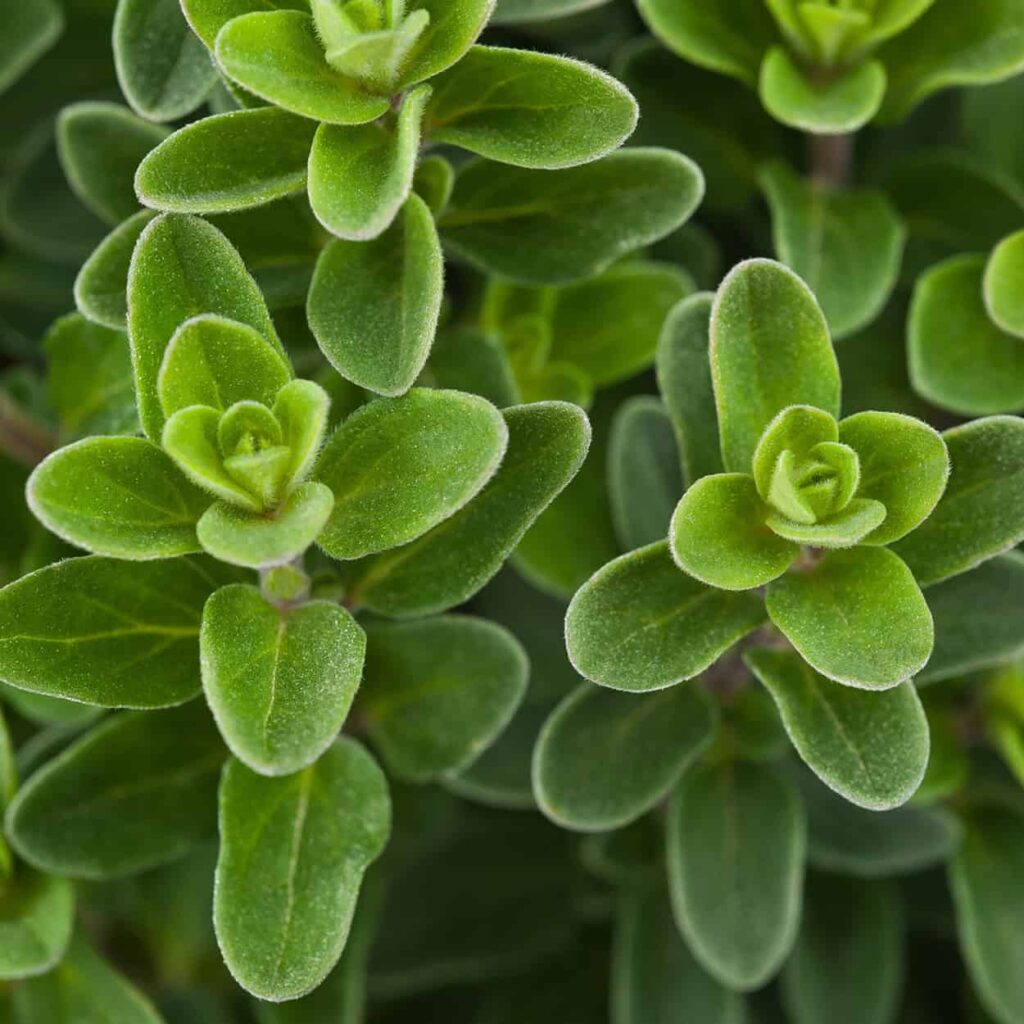
Marjoram (Sathra – H)
Energetics: VKP↑
Taste/Rasa: Pungent, astringent
Potency/Virya: Warming
Vipaka: Pungent
Actions: Stimulant, diaphoretic, expectorant
Indications: Colds, flu, weak digestion, promotes menstruation.
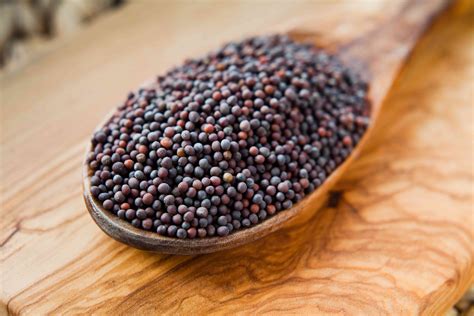
Mustard Seeds (Rajika- Brown; Sarshapah – Black)
Energetics: VK↓P↑; best Kapha spice
Taste/Rasa: Pungent
Potency/Virya: Warming
Indications: Laxative, 1 teaspoon ingested as an emetic for drunkenness, poisons. Clears head and sinuses, chronic colds and coughs. Hot mustard bath—as an emmenagogue. Ten-minute external paste—chest troubles, blisters, inflammatory nerve disorders, pain and swelling of the joints, edema, headache, abdominal colic and pain, obstinate vomiting; gout, sciatica, urticaria, arthritis.
Indications: Generally brown, are used quite a bit in Indian cooking. Brown mustard seeds are warming and impart the pungent taste, according to Āyurveda. They balance kapha and vāta but increase pitta doṣa. In Āyurveda, brown mustard seeds are considered digestive and good for alleviating stomach discomforts such as gas or cramps.
Heat a little ghee or oil in a pan. When hot, add the mustard seeds and wait until it sputters. Remove from heat and pour over the prepared dish. Stir and serve. Mustard seeds sautéed in ghee are wonderful in lentil soups, dals, Indian-style curries, and spiced vegetables. They have a sharp flavor and are aromatic as well.
Brown mustard seeds combine well with other Āyurvedic herbs and spices such as ginger, cayenne peppers, turmeric, asafetida, and coriander.
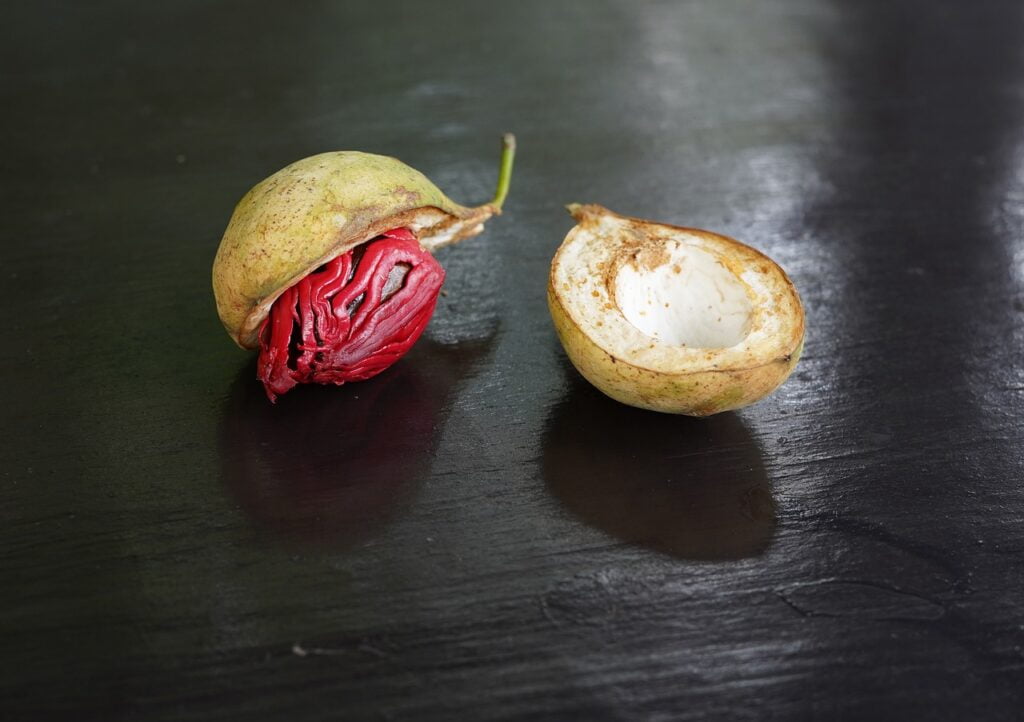
Nutmeg (Malathi-phalam; Jati-phalam)
Energetics: VKP↓; best sedative of all spices; tamasic
Taste/Rasa: Sweet, pungent, astringent
Potency/Virya: Warming
Vipaka: Pungent
Precautions: Pregnancy, high Pitta
Preparation: Infusion (do not boil), milk decoction, powder (250 to 500 mg)
Actions: Stimulant, carminative, astringent; use for abdominal pain, dysmenorrhea, insomnia, poor absorption (especially in the small intestine), abdominal distention, incontinence, diarrhea, dysentery, impotence, mental disorders (i.e., nervousness, anxiety, hysteria—prepared in milk decoction)
Description: Is one of the best spices for increasing absorption, particularly in the small intestine. It works well in this respect with such spices as cardamom and ginger. Taken in buttermilk, it improves assimilation and stops diarrhea. It helps reduce high Vata in the colon and in the nervous system. It is one of the best medicines for calming the mind. For this it can be taken 500 mg. in warm milk before sleep, to promote sound sleep. However, it has a tamasic quality, somewhat like poppy seeds, and in excess can increase dullness of mind.
It is good for incontinence of urine or for premature ejaculation. It also serves to relieve muscle-spasms, particularly of the abdomen.
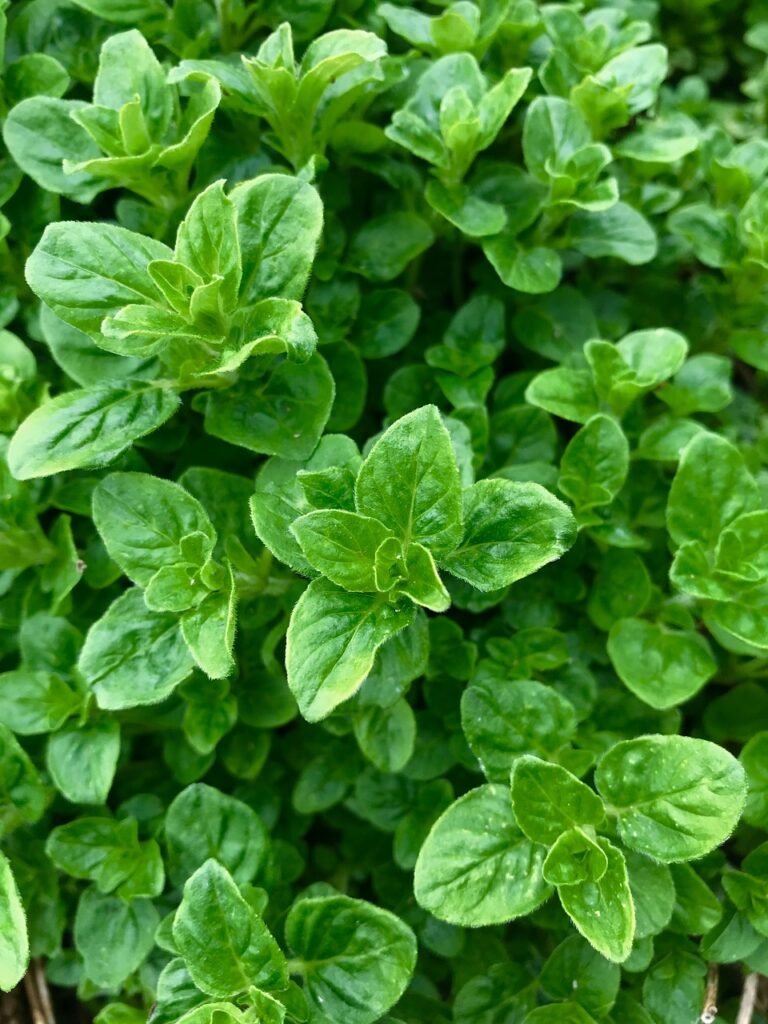
Oregano
Energetics: VKP↑
Taste/Rasa: Sour, astringent
Potency/Virya: Warming
Vipaka: Pungent
Actions: Stimulant, diaphoretic, carminative, analgesic, antiseptic
Indications: Colds, cough, nausea, morning sickness, dysmenorrhea, gas, indigestion. Excellent for severe distention.
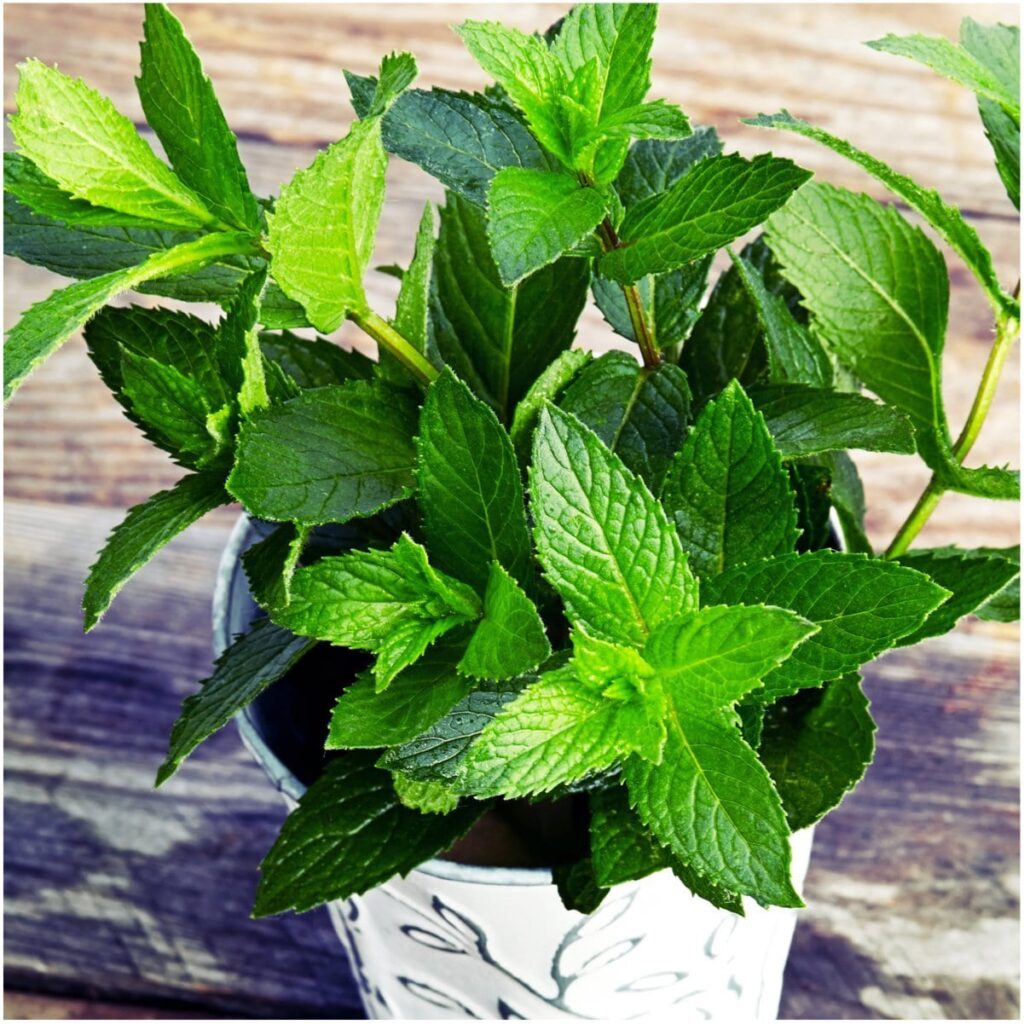
Peppermint (Paparaminta – H)
Energetics: VKP↓
Taste/Rasa: Sweet
Potency/Virya: Cold
Vipaka: Pungent
Actions: Stimulant, diaphoretic, carminative, analgesic
Indications: Colds and flu, fevers, and sore throat; clears head, sinuses, allergic headaches, and hay fever; opens mind and senses; promotes emotional harmony.
Description: Have a mild soothing action on the nerves and digestion, which helps relax the body and clear the mind and senses, hence their widespread popularity and usage. They are mild, cooling diaphoretics for common colds and flus and their complications. Is the most stimulating mint and the best one to improve digestion.
Mints contain large amounts of the element of ether, whose action is soothing, cooling, clarifying and expanding. Through their ethereal nature they help relieve mental and emotional tension and congestion. Their nature is sattvic.
Their action on the body is mild and not strong enough for acute or severe ailments. They are usually used with other herbs in an auxiliary role as harmonizing agents or as anuyanas.
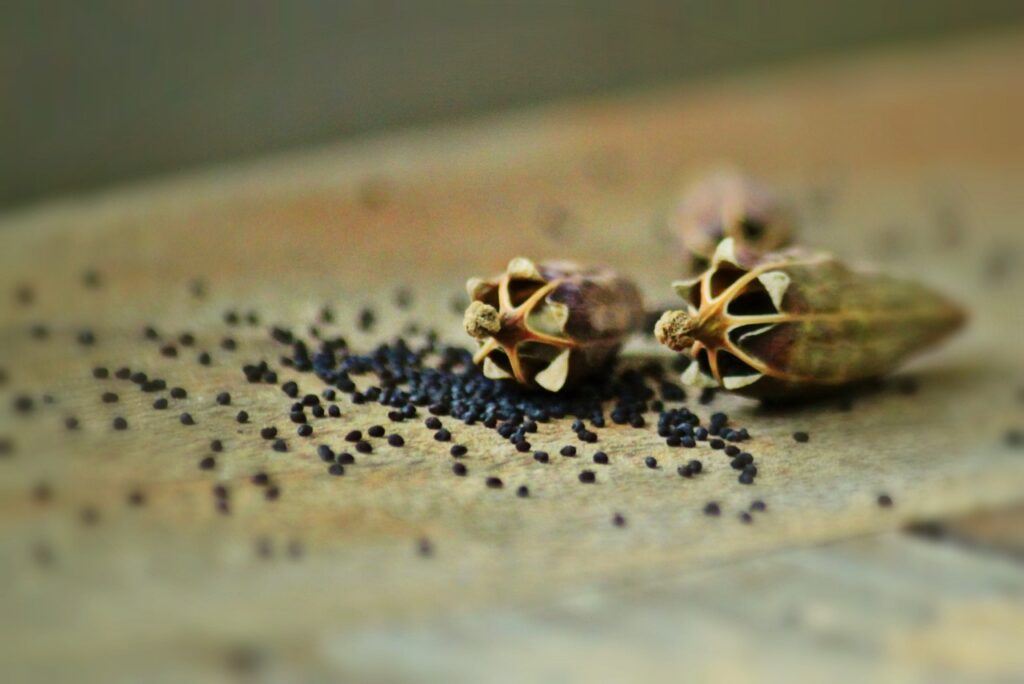
Poppy Seeds (Kasa bijam)
Energetics: VKP↑
Taste/Rasa: Sweet, astringent
Potency/Virya: Hot
Vipaka: Pungent
Tissues: Plasma, blood, muscle, bone, marrow and nerves
Actions: Stimulant, antispasmodic, astringent
Precautions: Gastritis, colitis, high Pitta
Indications: Diarrhea, dysentery, children’s diarrhea, abdominal pain, poor absorption, cough, insomnia, nerve pain
Description: Similar in properties to nutmeg and are often used in conjunction with it. They are a good astringent for the intestines, possessing carminative and stomachic properties, thus also increasing Agni while promoting absorption. They are effective for nervous digestive disorders of children or of high Vata types. They strengthen the villi of the small intestine. As a spice, they are antidotal to the gas-producing properties of legumes.
Their quality is tamasic. They induce sleep and, in long term usage, dull the mind and so may inhibit awareness, though they do help bring down high Vata psychological imbalances. As a nervine they may be used with valerian.
One-quarter ounce of poppy seeds can be simmered in one pint of water along with one teaspoon each of nutmeg and ginger powder and taken three times a day immediately after meals for nervous digestion. A cup may also be taken before sleep to promote rest.
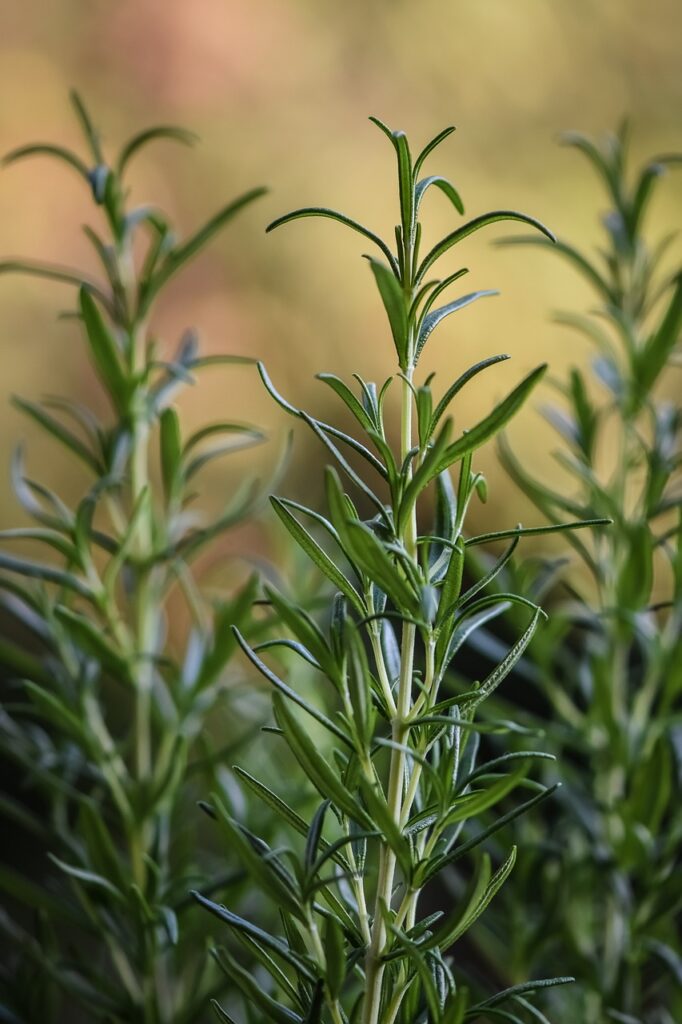
Rosemary
Energetics: VK↓ P↑ mildly
Taste/Rasa: Pungent, bitter
Potency/Virya: Hot
Vipaka: Pungent
Actions: Stimulant, diaphoretic, excellent emmenagogue
Indications: Eases menstruation, headaches, harmonizes and strengthens heart and emotions.
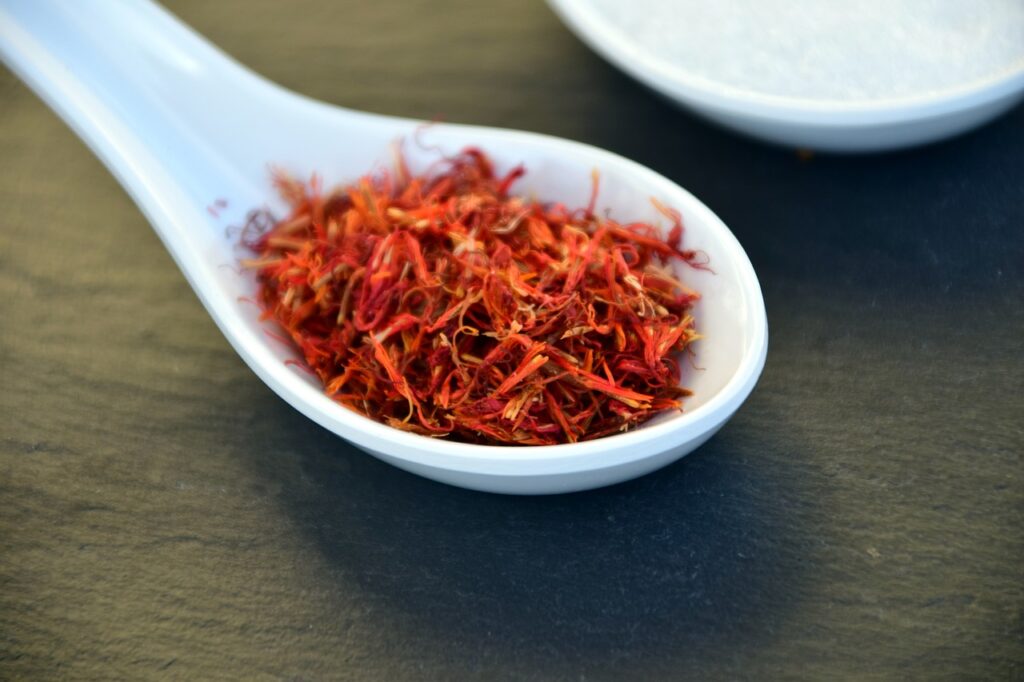
Saffron
Energetics: VPK↓; sattvic
Taste/Rasa: Pungent, bitter, sweet
Potency/Virya: Cooling
Vipaka: Sweet
Actions: Alterative, emmenagogue, aphrodisiac, rejuvenative, stimulant, carminative, antispasmodic
Preparation: Infusion, milk decoction, powder (100 to 250 mg); use in low dosages, a pinchful with other herbs, medicated oil, medicated ghee
Indications: Is a royal spice. In Āyurveda, saffron is considered tridoṣic: balancing for all doṣas. It helps in the assimilation of nutrients and dhātu formation and flushing toxins out of the tissues of the body. Saffron is available as strands or as a powder. Saffron strands are normally soaked in a little warm milk to release the color before adding to dishes. In Āyurvedic cooking, saffron is used widely in desserts, vegetable dishes, and rice dishes. It is used for both its royal color and delicate aroma. Saffron combines well with almost every other Āyurvedic spice.
SAFFLOWER, sometimes misleadingly called saffron, can be used as a substitute for saffron and is much less expensive. It should be used in normal dosages.
Precautions: Pregnancy (can promote miscarriage), in large doses is narcotic
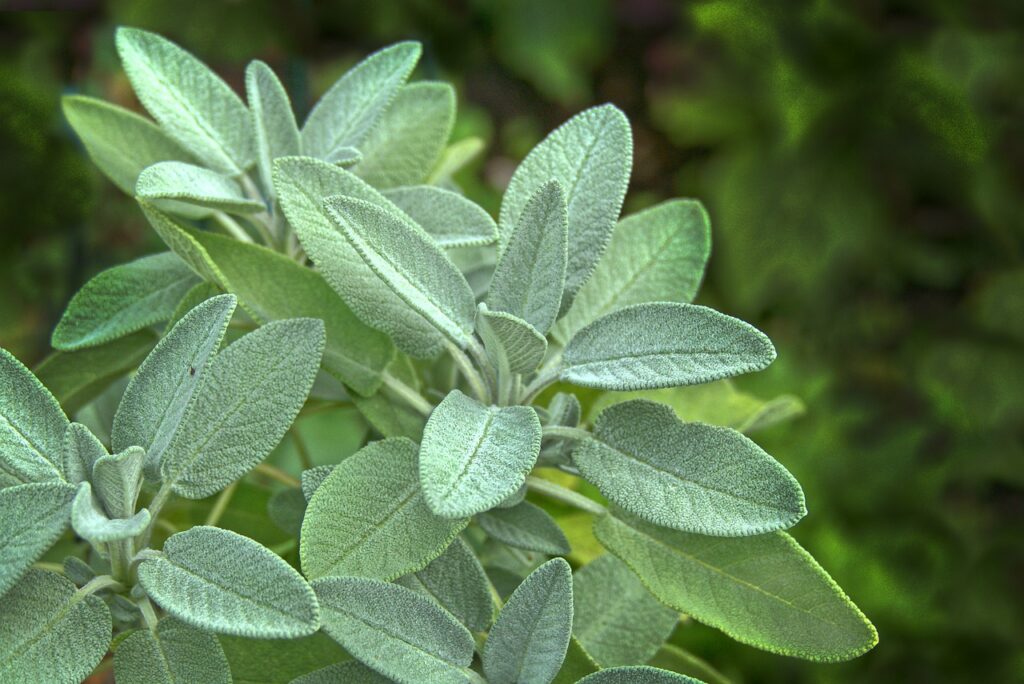
Sage (Salbia-sefakuss – H)
Energetics: VK↓ (P↑ in execess)
Taste/Rasa: Pungent, astringent
Potency/Virya: Hot
Vipaka: Pungent
Tissues: Plasma, blood, nerve
Actions: Stimulant, diuretic, nervine, astringent
Precautions: High Vata (excessive dryness), nursing mothers
Indications: Colds, ffus, sore throat, laryngitis, swollen lymph glands,night sweats, spermatorrhea, hair loss, nervous dysfunction
Description: Opens the lungs, head, sinuses; sore throat; clears srotas, voice, perception, thought; relieves excessive sexual desire, calms heart, digests meat and dairy, reduces excess secretions in body (i.e., stops the flow of milk in nursing women, swollen lymph glands, dries excess mucus in lungs and nose, dries sores, ulcers, and bleeding; and night sweats), is a diuretic for urinary tract problems, calms the brain.
SAGE has a strong action for reducing excess secretions in the body. It stops sweating, is a specific for night sweats. It dries up excess mucus from the nose and lungs, as well as excessive salivation. It suppresses mammary secretions and withholds seminal discharge. It also dries up sores and ulcers and stops bleeding. As such it is mainly for reducing high Kapha. Taken hot, it is diaphoretic and expectorant and is good for Kapha and Vata. Taken cold, it is astringent and diuretic and is better for Pitta.
For the brain and nervous system and promoting the growth of hair, it combines well with gotu kola or bhringaraj. Sage has a special power to clear emotional obstructions from the mind and promote calmness and clarity. It helps reduce excessive desires and passions. It is specific for calming the heart.
It makes a good gargle for sore throat and a good wash for bleeding sore.
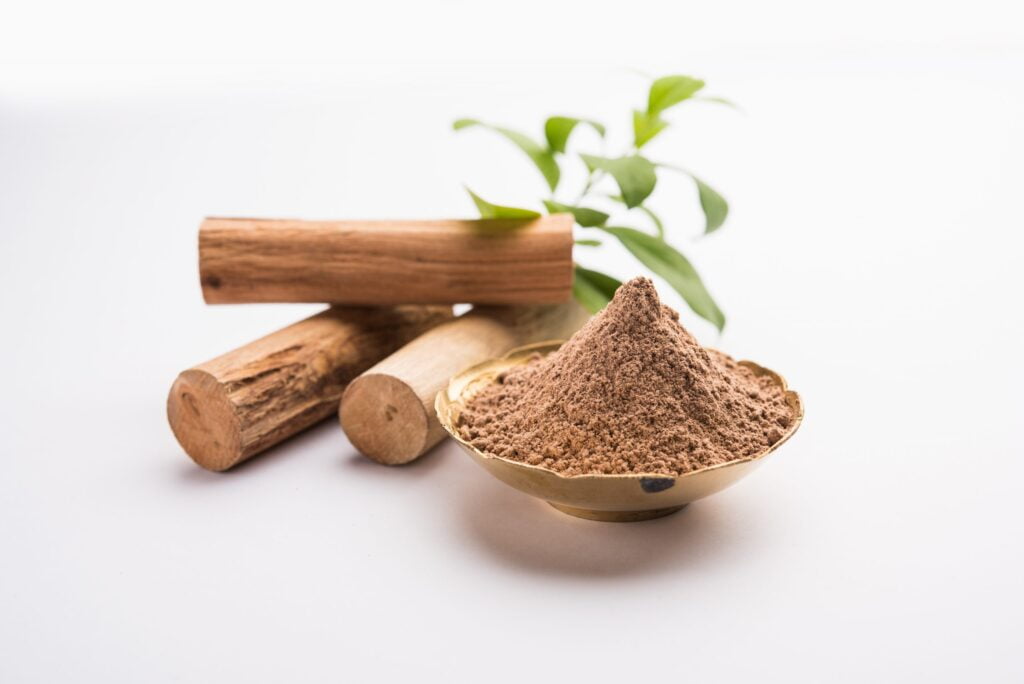
Sandalwood (Chandana)
Energetics: VP↓ K↑ or (Ama+ in excess)
Taste/Rasa: Bitter, sweet, astringent
Potency/Virya: Cooling
Vipaka: Sweet
Tissues: Plasma, blood, muscle, marrow and nerve, reproductive
Actions: Stimulant, diuretic, nervine, astringent
Precautions: High Kapha, severe lung congestion
Indications: Infusion (hot or cold), decoction, powder (250 mg to 1 g), medicated oil
Preparation: Colds, ffus, sore throat, laryngitis, swollen lymph glands, night sweats, spermatorrhea, hair loss, nervous dysfunction
Description: cools and calms the entire body and mind, with its influence spreading throughout the circulatory, digestive, respiratory and nervous systems. It relieves fever, thirst, burning sensation and stops sweating. A few drops of sandalwood oil applied to the third eye will relieve heat and thirst, and is good for fever or overexposure to the sun.
Sandalwood helps the awakening of intelligence. Its prabhava is to help open the third eye, to increase devotion and promote meditation. It also aids in the transmutation of sexual energy.
Sandalwood, a good addition to other formulas, reduces fever; it is good for almost any inflammatory conditions and for cleansing the blood. Externally, the oil or paste can be used for most infectious sores or ulcers. In short, sandalwood is a very good anti-Piiw medicine.
A strong sandalwood oil can be made by steeping four ounces of sandalwood powder in one pint of cold water overnight, adding to one pint coconut oil and cooking over a low flame (not boiling), until all the water evaporates.
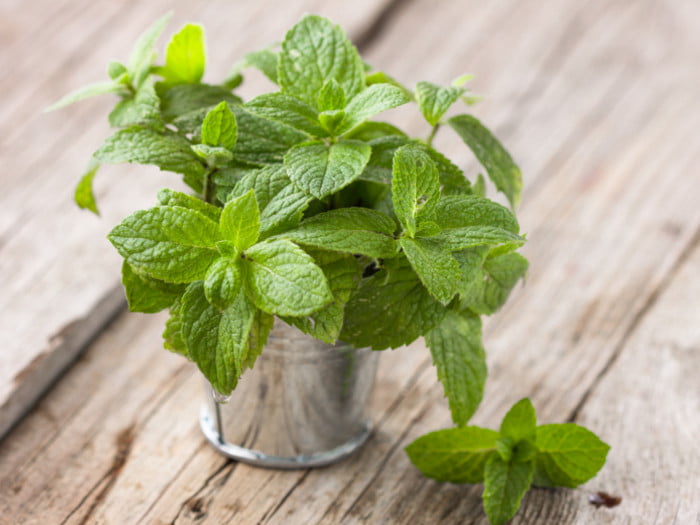
Spearmint (Pahadi pudina – H)
Energetics: VPK↓
Taste/Rasa: Sweet
Potency/Virya: Cold
Vipaka: Pungent
Actions: Stimulant, diaphoretic, diuretic, calmative
Indications: Painful, difficult or burning urine (cold), colic, indigestion, and sleep in children, nausea, vomiting, morning sickness.
Description: Have a mild soothing action on the nerves and digestion, which helps relax the body and clear the mind and senses, hence their widespread popularity and usage. They are mild, cooling diaphoretics for common colds and flus and their complications.
Is more relaxing and better in diuretic action (i.e. for urinary inflammation).
Mints contain large amounts of the element of ether, whose action is soothing, cooling, clarifying and expanding. Through their ethereal nature they help relieve mental and emotional tension and congestion. Their nature is sattvic.
Their action on the body is mild and not strong enough for acute or severe ailments. They are usually used with other herbs in an auxiliary role as harmonizing agents or as anuyanas.
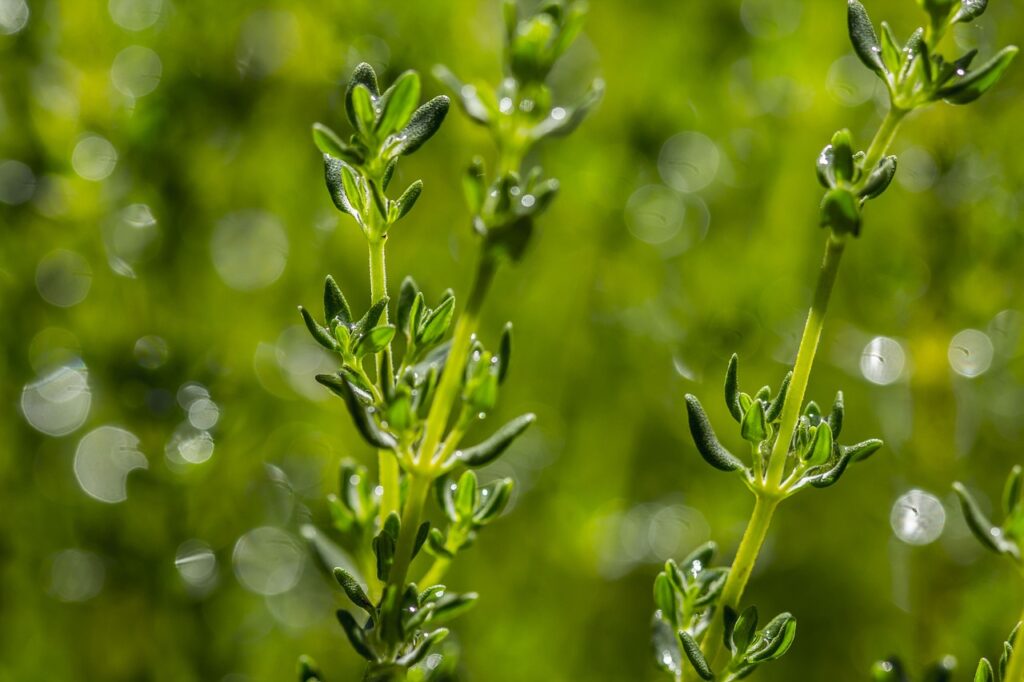
Thyme (Ipar – H)(Pahadi pudina – H)
Energetics: VK↓ P↑
Taste/Rasa: Pungent
Potency/Virya: Hot
Vipaka: Pungent
Actions: Stimulant, diaphoretic, anticough, anthelmintic, antiseptic
Indications: Severe cough, whooping cough, bad breath, indigestion, gas, menstrual disorders.
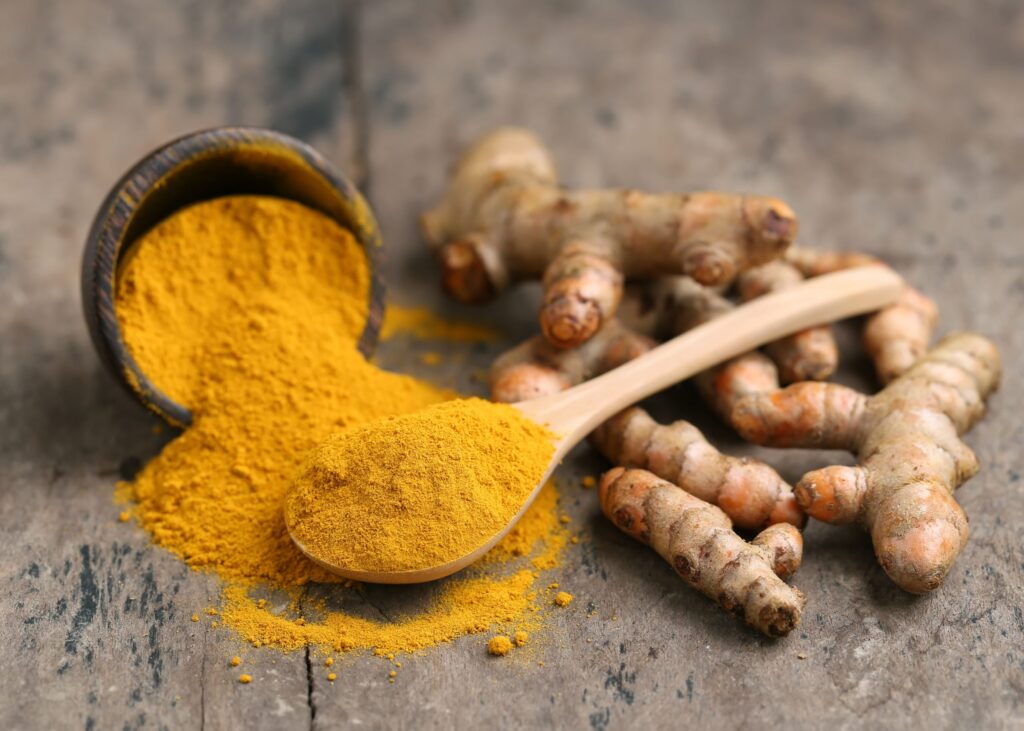
Turmeric
Energetics: VPK↓
Taste/Rasa: Pungent, earthy-sweet taste
Potency/Virya: Hot
Vipaka: Pungent
Actions: Stimulant, carminative, alterative, vulnerary, antibacterial
Indications: Is ubiquitous in Āyurvedic cooking. It contains flavonoid curcumin, which is known to have anti-inflammatory properties. This all-around wonder spice is said to help detoxify the liver, balance cholesterol levels, fight allergies, stimulate digestion, boost immunity and enhance the complexion. It is also an antioxidant. Āyurveda recognizes it as a heating spice, contributing bitter, pungent, and astringent tastes.
Turmeric is a bright yellow-orange spice, and, used in tiny quantities, imparts a rich color to cooked white rice, potatoes, or yellow lentils. It is added to the water in which rice or lentils are being cooked. It combines well with other spices such as cumin, coriander, cayenne pepper, and cinnamon. Here’s a quick, easy way to enjoy turmeric. Sauté half a teaspoon of cumin seeds, half a teaspoon of turmeric, and half a teaspoon of sweet paprika in a tablespoon of Ghee. Remove from heat as the spices start to release their aroma and stir in a cup of diced steamed vegetables such as zucchini, cauliflower, or broccoli. Add salt to taste and garnish with some chopped fresh cilantro. Cooked red kidney beans or cooked lentils also work well with this spice mixture.
Precautions: Turmeric can stain fabrics and other materials, so handle carefully. Precautions: acute jaundice and hepatitis, high Pitta, pregnancy




